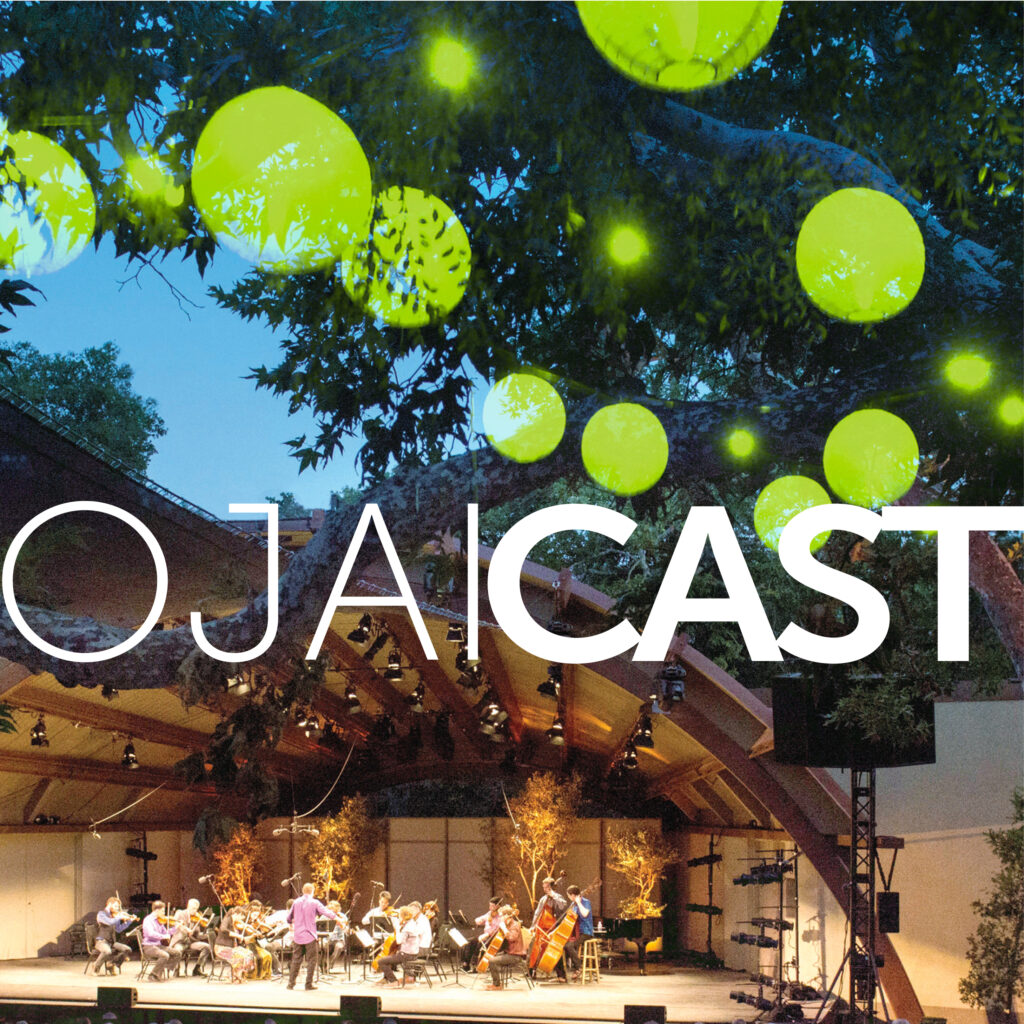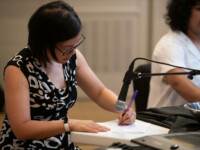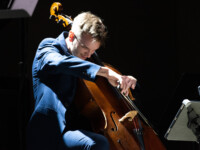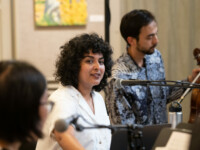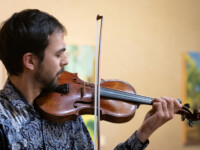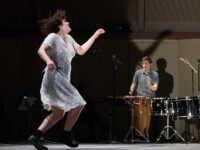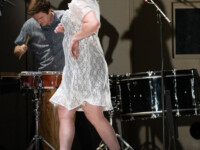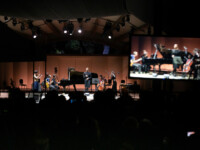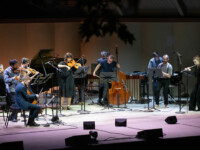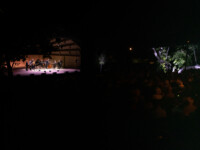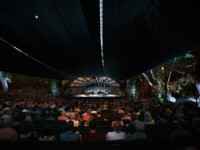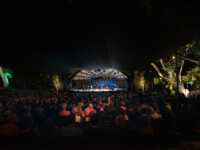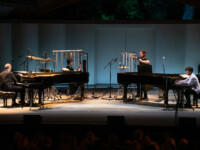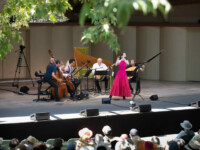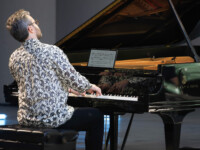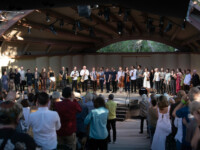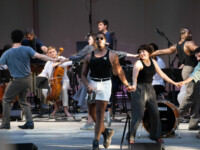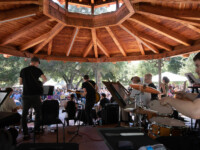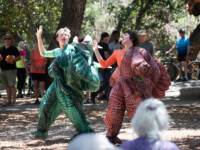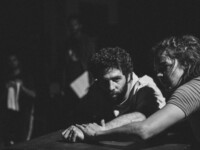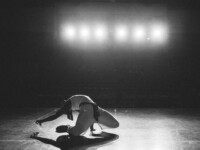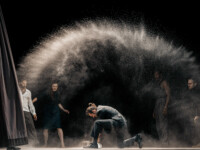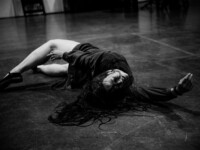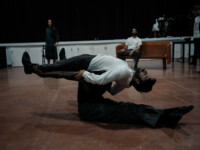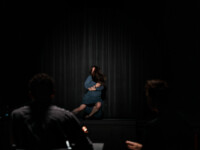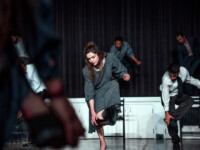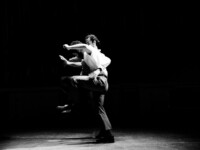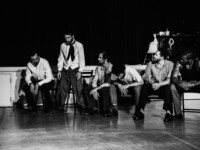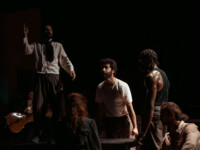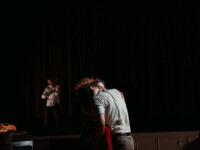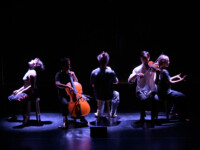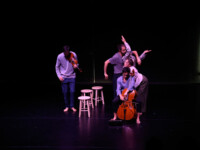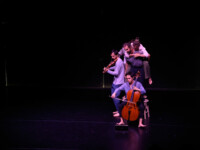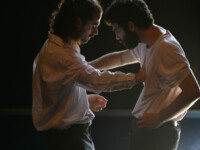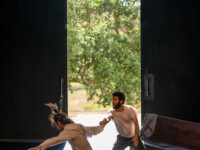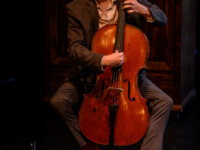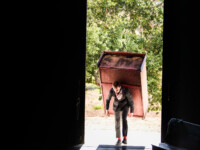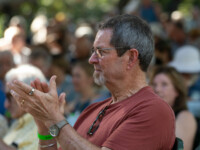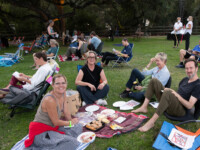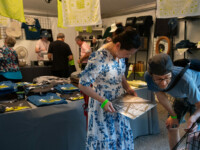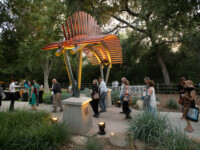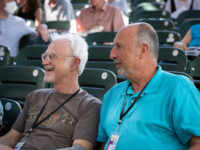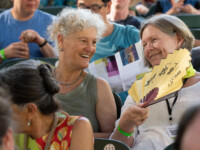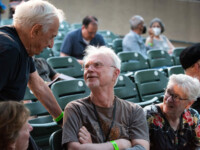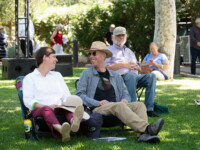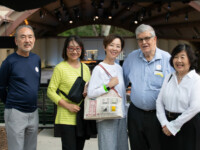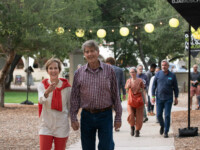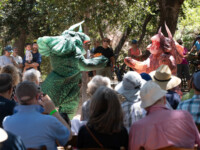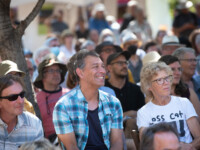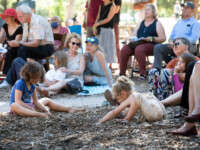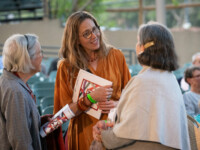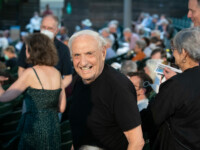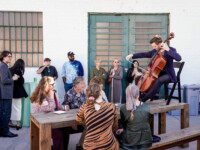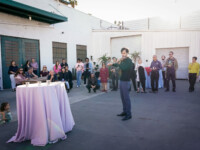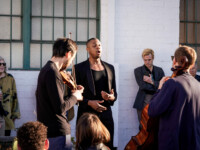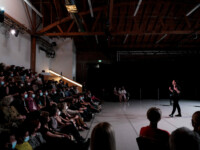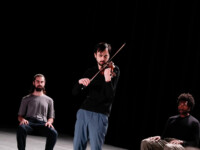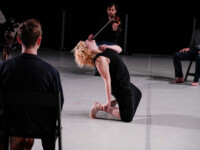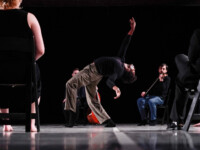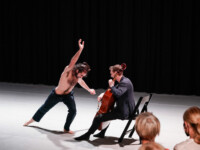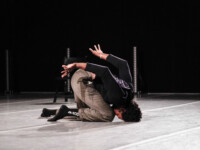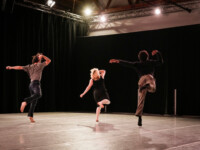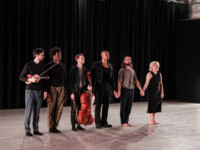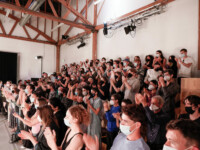Program Notes
Thursday, June 8, 2023 | 8:00pm
LIQUID BORDERS – Program Notes
Rhiannon Giddens vocals | Kayhan Kalhor kamancheh | Steven Schick percussion/director | red fish blue fish percussion | Attacca Quartet: Amy Schroeder and Domenic Salerni violins Nathan Schram viola Andrew Yee cello
Gabriela ORTIZ (b. 1964)
Liquid Borders (2013)
Joseph HAYDN (1732-1809)
Andante from String Quartet in F major, Op. 77, No. 2 Hob. III:82 (1799)
Zakir HUSSAIN (b. 1951)
Pallavi (2017)
Philip GLASS (b. 1937)
First Movement from String Quartet No. 3 (“Mishima”) (1985)
Colin JACOBSEN (b. 1978)
Beloved, Do Not Let Me Be Discouraged (2008)
Geeshie WILEY
Last Kind Words
Arranged by Jacob Garchik
Rhiannon GIDDENS (b. 1977)
Lullaby
David CROSBY (1941-2023)/ Nathan SCHRAM (b. 1987)
Where We Are Not (2020)
Caroline SHAW (b. 1977)
Stem and Root from The Evergreen (2022)
John ADAMS (b. 1947)
Judah to Ocean and Rag the Bone from John’s Book of Alleged Dances (1994)
SQUAREPUSHER (Tom Jenkinson, b. 1975)
Xetaka 1 (2021)
No Boundaries
Liquid Borders: Both the title and the premise of the percussion quartet by Gabriela Ortiz that opens this edition of the Ojai Music Festival could not be better suited to Rhiannon Giddens’s curatorial vision. The Mexico City–based Ortiz has created a body of boundlessly imaginative work animated by adventurous border crossings between strikingly different realms: folk and avant-garde, Latin American and European, acoustic and electronic.
Ortiz comes from an influential musical family. Her parents were among the earliest members of the still-active group Los Folkloristas, founded in 1966, which transformed the understanding of Latin American folk music. A composer who asserts that “sounds have souls,” she has developed a special connection to California ensembles, producing works for the Los Angeles Philharmonic and the Kronos Quartet.
Explorations of folklore and folk music, pre- and post-colonial, play a prominent role in Ortiz’s music. She combines these sources with contemporary techniques to generate unprecedented yet somehow inevitable sounding and extraordinarily evocative musical spaces.
Liquid Borders originated as a commission from Steven Schick for his University of California at San Diego–based percussion ensemble red fish blue fish and was premiered at the Banff Centre in Canada in August 2014. The title refers not only to dissolving aesthetic barriers but to Ortiz’s utopian reflection on what it might be like to overcome the artificial divisions she believes are put in place for political and economic reasons.
But because those divisions are in place, they exacerbate injustices caused by changes in the economy, society, and climate, which Ortiz illustrates in the varied soundscapes corresponding to each of the work’s three movements. The metallic and glass percussion of “Liquid City” conjures an urban landscape that, according to the composer, refers to the problem of impoverished immigrants from Mexico’s countryside facing desperate conditions when they seek economic improvement in the cities. In “Liquid Desert,” the soundscape changes dramatically to ghostly, dry, dark, rattling sounds. The social context here involves the problem in the north of Mexico caused by cheap maquila factories that exploit impoverished women. The players are instructed to whisper the word maquila to represent “these lost voices of women who have disappeared or been killed.” “Liquid Jungle” uses the timbres of marimbas, bongos, and woodblocks to evoke the scene at Mexico’s southern border, with driving rhythms derived from Caribbean and African music. The life force itself pulses with irresistible energy and cannot be contained.
Liquefying the borders between genres and disciplines is a signature of the Attacca Quartet. The playlist they’ve put together to launch their Ojai residency presents a self-portrait of the ensemble and their voracious appetite for trying new things. But rather than a straightforward, realist style, it’s a portrait painted in wildly abstract colors, “where our past and our future are simultaneously reflected in some form,” as cellist Andrew Yee puts it. “Asking what our artistic vision adds to this already rich art form has freed us up to experiment with the framework of our programming.”
The “Haydn 68” project — a cycle of all of the composer’s quartets, which Attacca performed from 2010 to 2016 — left a lasting mark on the quartet’s sound. They play the Andante from Haydn’s last completed work in the medium, composed in 1799 and deemed by the composer himself as his “most beautiful string quartet.” Beginning with an almost folklike duet for just violin and cello, Haydn varies the main idea in profoundly surprising ways.
Zakir Hussain composed Pallavi in 2017 as part of Kronos Quartet’s 50 for the Future project to create repertory for a new generation of music lovers; Reena Esmail prepared this arrangement. The composer has provided this commentary: “Pallavi is the ancient Carnatic word for ‘composition.’ Each raga would have at least 100 traditional compositions of this type. The piece as written follows the prescribed format of the ancient Pallavi in which there is first Pallavi, then Anu Pallavi followed by Charnam…..Unlike the traditional Pallavi based in one raga, I have used four different ragas and tried to find a way to give each instrument its own personality with a raga assigned just for it. By doing so I hoped to address the Western system, which employs counterpoint and harmony, through the multi-tonal play of the four ragas working in tandem in certain passages. There is also interplay between different rhythm cycles (Tala) using 4, 6, 9, and 16 beats, each assigned to an instrument in the quartet.”
As with the Haydn piece, economy of means is at the fore in Philip Glass’s String Quartet No. 3. It derives from his score for Paul Schrader’s biographical film about the Japanese writer Mishima (1985). The Attaccas recorded the work on their 2021 album Of All Joys, which juxtaposes music of the Renaissance with the Minimalist aesthetic. Beloved, Do Not Let Me Be Discouraged began as a collaboration between Kayhan Kalhor and the string quartet Brooklyn Rider. Working on a production with the Silkroad Ensemble, the violinist Colin Jacobsen had become fascinated by Layla and Majnun, the story of star-crossed lovers immensely popular in the Middle East (whose Western counterpart is often said to be Romeo and Juliet). Knowledge of the rich tradition of Persian music is no prerequisite to being swept away by Kalhor’s depiction of the state of love-madness central to the telling of the story, with its anticipation of medieval European troubadours.
To embark on their collaboration with Rhiannon Giddens at the 2023 Ojai Music Festival, the musicians have chosen two especially characteristic songs: Last Kind Words, which Giddens covers on her debut solo album from 2015 (Tomorrow Is My Turn), was written and recorded by Geeshie Wiley in 1930 and condenses an evocative drama into the country blues idiom. Giddens’s Lullaby, from her 2017 album Folk Songs with the Kronos Quartet, only hints at the underlying situation, endured by countless enslaved women, that makes it so heartbreaking: “such a shame now, little baby, that you are not my own.”
In memory of the late David Crosby, who died at his ranch in nearby Santa Ynez in January, the Attacca Quartet performs a piece that violist Nathan Schram wrote with the legendary songwriter called Where We Are Not. Schram transformed the song I’d Swear There Was Somebody Here from Crosby’s debut solo album of 1970 (If I Could Only Remember My Name) into a haunting new composition on his solo record Nearsided, which he arranged for Attacca. “It’s about people we had both lost in the past but now has taken on a new meaning,” says Schram.
The Attaccas also pay tribute to their close collaboration with composer Caroline Shaw, offering selections from their most recent recording, which won a Grammy Award this year. Shaw’s quartet writing is often inspired by gardens and trees — as is the case with The Evergreen, a four-movement work she has described as “an offering” to a tree in a coniferous forest on one of the islands in the Salish Sea separating Canada and the U.S. Shaw’s vivid, gestural writing for the strings reclaims the Romantic aspiration toward “organically” inspired art for our climate- anxious time.
A decade ago, on their Fellow Traveler album devoted to the string quartet music John Adams had written up to that point, Attacca Quartet put their own stamp on his 1994 collaboration with the Kronos Quartet, John’s Book of Alleged Dances. They play two of the 10 dances — whose “general tone is dry, droll, sardonic,” according to the composer — that call for a pre-recorded percussion track played by prepared piano.
One of the Attacca Quartet’s most experimental projects to date in crossing borders is their 2021 album Real Life, which gave them a platform to repaint the musical canvases of leading artists and producers in electronica and avant hip-hop, including Squarepusher. Their blending of the string quartet — historically, a benchmark of acoustic intimacy — with the contemporary dance floor’s amplified reverberations can sound by turns thrillingly chaotic and serenely surreal.
—THOMAS MAY
Friday, June 9, 2023 | 8:00am
OJAI DAWNS – Program Notes
Emi Ferguson flute | Ross Karre percussion | Tara Khozein soprano | Niloufar Shiri kamancheh | Aida Shirazi electronics | Steven Schick percussion | red fish blue fish percussion
Golfam KHAYAM (b. 1983)
Lost Wind (2018)
co-composed by Aida Shirazi and Niloufar Shiri
Yearning, Every Dawn (2023)
Edgard VARÈSE (1883-1965)
Density 21.5 (1936)
CHOU Wen-Chung (1923-2019)
Echoes from the Gorge (1989)
Calligraphies of Sound
For all its antiquity, the flute has taken a lead, liberating role in the transition to modernism. Pierre Boulez cited Prélude à l’après-midi d’un faune as the “origin” point of modern music. Georges Barrère, who played the epochal flute solo that begins Debussy’s trailblazing score at its premiere in 1894, asked Edgard Varèse to write Density 21.5 for him 42 years later. In Lost Wind, Golfam Khayam similarly uses the flute to imagine a new sound world. But the reference point in her case is the rich and diverse Persian classical music tradition.
Like many composers of her generation, Khayam ventured outside her native Iran to continue her studies. After immersing herself in contemporary experimental music in Cincinnati and Geneva, she returned to Iran and now teaches in Tehran. Lost Wind is a written score but breathes the spirit of improvisation that is central to Persian music and offers the flute soloist ample opportunity to make individual choices about phrasing and rhythmic articulation. Extended techniques calling for breathing in and out of the instrument, bending pitch, “aeolian sound,” and the like suggest a wordless poetry being communicated. Khayam’s accompaniment with the deeper-rimmed heng gong (a favorite of sound healers) seems to extend the flute’s own voice, often playing in its low range but ascending to the heights at the climax.
Aida Shirazi also refracts Persian traditions through a contemporary and experimental perspective, combining layers of live and processed electronics with onstage improvisation by the kamancheh virtuoso Niloufar Shiri in her new work Yearning, Every Dawn. While growing up in Iran, Shirazi was trained classically in both Persian and Western music and went on to study in Turkey and at the University of California at Davis, where she recently completed her doctorate. A co-founder of the Iranian Female Composers Association (see sidebar on p. 48), Shirazi was able to realize her desire to collaborate with two admired colleagues for her Ojai Music Festival commission (one in live performance and the other through a pre-recorded tape).
In addition to performing and improvising live, Shiri provided Shirazi with recordings of her work to be incorporated into the processed and pre-recorded electronics. The Iranian American soprano Tara Khozein contributed another layer by recording a short improvisatory song based on a text (see p. 48) by the 19th-century poet Táhirih Qurrat al-’Ayn, which was also processed. Shirazi, who spent a period training at IRCAM in Paris, has woven these recorded materials into Yearning, Every Dawn, thus combining sources that are acoustic and electronic, live and recorded, played and sung, improvised and fixed. Rather than merely juxtapose traditions and sound worlds, she aims to create “a hybrid that will sound as natural and organic as possible — so that it’s all of them, and at the same time none of them, but with my voice.”
Edgard Varèse is often cited as a tutelary spirit to colorful figures of the Western avant-garde (Boulez, Stockhausen, Frank Zappa), but his influence extended to non-Western composers. He left an indelible mark on Chou Wen-Chung (see sidebar on p. 64), who became his student and copyist when they met in 1949 and, following the death of Varèse, his literary executor. Density 21.5 dates from the previous decade (1936) and was composed for the above-mentioned Georges Barrère, who planned to inaugurate a newly engineered platinum flute at the upcoming New York World’s Fair. The title refers to the density or specific mass of this rare metal, which is 21.5. (Cocktail party conversation point: The new flute was in fact a platinum-iridium alloy with an estimated specific mass of 21.6.) Varèse crafts a novel language from alterations in timbre, use of the extreme high and low ends of the register, and percussive effects.
Varèse mentored the young Chou Wen- Chung, who in turn had a profound influence on the generation of composers emigrating from China after the Cultural Revolution (including Ge Gan-Ru, Lei Liang, and Tan Dun). Chou Wen-Chung anticipated their quest to synthesize Asian and Western idioms in his own integration of classical Chinese aesthetics with a contemporary sensibility. Also a prominent scholar, Chou Wen-Chung described Varèse’s concept of sound as “living matter” as “a modern Western parallel of a pervasive Chinese concept: that each single tone is a musical entity in itself, that musical meaning lies intrinsically in the tones themselves, and that one must investigate sound to know tones and investigate tones to know music.”
This overarching idea pervades the subtly fluctuating soundscape of Echoes from the Gorge, completed in 1989 after a lengthy break from composition during which Chou Wen-Chung had worked on his edition of Varèse’s scores. Among Chou Wen-Chung’s most substantial works, Echoes is regarded as on one level a tribute to his former mentor as well.
Chou Wen-Chung organizes his quartet of percussionists to preside over a vast panoply of instruments. These are divided into various family groups based on timbre (wood, metal, skin, and various other kinds of drums), articulation, and even where and how the instruments are struck.
Chou Wen-Chung’s devotion to Chinese calligraphy and its philosophy also informs the shaping of sounds in a delicate balance between predetermination and seeming spontaneity. In the view of Steven Schick, Echoes from the Gorge ranks with the most significant yet overlooked works for percussion written in the 20th century. Comprising an introduction and 12 sections labeled with nature imagery (“echoes from the gorge,” “falling rocks and flying spray,” etc.), the piece reflects what Chou Wen-Chung described as “the preeminent musical form in East Asia, wherein all sections of a composition are elaborations or reductions of one and the same nuclear idea.”
—THOMAS MAY
Friday, June 9, 2023 | 10:00am
VIS-À-VIS – Program Notes
Lara Downes piano | Gloria Cheng piano | Emi Ferguson flute | Mario Gotoh viola | Leonard Hayes piano | Karen Ouzounian cello | Joshua Rubin clarinet | Steven Schick percussion | Michi Wiancko violin | Wu Man pipa
Due to injury, pianist Leonard Hayes has had to reduce his playing commitments and has withdrawn from this concert. We are deeply grateful to Lara Downes for agreeing to step in on short notice. Please note the revised program:
Shawn OKPEBHOLO (b. 1981)
Amazing Grace
H.T. BURLEIGH (1866-1949)
On Bended Knees (1910)
Margaret BONDS (1913-72) Troubled Water (Wade in the Water) (c. 1930s-40s)
Michael ABELS (b. 1962)
Iconoclasm (2017)
Jessie MONTGOMERY (b. 1981)
Rhapsody No. 2
Nasim KHORASSANI (b. 1987)
Growth (2017)
Nina BARZEGAR (b. 1984)
Inexorable Passage (2020)
Lei LIANG (b. 1972)
vis-à-vis (2018)
Face to Face
The face of American concert music has been changing dramatically in our time, immeasurably enriched by the acknowledgment and celebration of voices that, not long ago, were largely excluded. Contributions by woefully undervalued Black American composers of the past are finding eager new audiences, and young artists of color are galvanizing the scene by bringing their own perspectives to classical traditions. This morning’s program spans three generations of composers active today, with a nod to a rediscovered elder from the last century.
Commissioned as part of a project inspired by Maurice Ravel’s Miroirs, Shawn Okpebholo’s mi sueño: afro-flamenco responds to the Spanish-flavored fourth movement, “Alborada del gracioso” (“The Jester’s Morning Song”), from Ravel’s original piano suite. The title (“my dream: afro-flamenco”) combines his “pre- pandemic nostalgia” with “post-pandemic dreams” to travel again and revisit Spain and Africa. References to flamenco as well as rhythms and idioms inspired by his Nigerian musical heritage and African American music convey the composer’s longing to reconnect to these sources.
American Tableau (Tableau XI) is one of a larger cycle of a dozen pieces, each for a different solo instrument, by Tyson Gholston Davis, the youngest composer on Leonard Hayes’s opening set for solo piano. Davis interrogates the straightforward assurance of the melody known as “America the Beautiful” — and the betrayal of the values it signifies — by weaving it into a chromatically ambivalent context.
A student of Florence Price who later collaborated with her and with the poet Langston Hughes, the composer and pianist Margaret Bonds in 1933 became the first Black musician to perform with the Chicago Symphony. Troubled Water originated as the finale of a three-movement suite Bonds composed to bring her solo recitals to a rousing close. Rather than a mere “arrangement” of a famous spiritual, Bonds offers a multifaceted pianistic fantasy infused with idioms from jazz and European Romanticism. The words to “Wade in the Water,” her source, originally encoded lifesaving information for fugitives following the Underground Railroad to freedom.
For her album marking the Leonard Bernstein centennial in 2018, the pianist Lara Downes asked an array of composers to write short pieces honoring his legacy. Michael Abels explains that he sought to convey his impressions of “the personality and not the sage” in his witty Iconoclasm. Bouncy rhythms and restlessly shifting meters echoing Bernstein’s own style evoke how he embodied “the puckish life of the party.”
Musical America’s Composer of the Year for 2023, Jessie Montgomery grew up amid the rebelliously creative experimental scene of Manhattan’s Lower East Side in the 1980s. Both her parents led active careers in the performing arts, and their home became a meeting place for boundary-crossing musicians from free jazz; their prodigy daughter meanwhile pursued training in classical violin and began composing as a child. Rhapsody No. 2 is part of set of in-progress solo violin works, each dedicated to a particular contemporary violinist. Citing Béla Bartók as one of her inspirations, Montgomery wrote No. 2 for Michi Wiancko, who included it on her Planetary Candidate album (released in 2020).
Both Nasim Khorassani and Nina Barzegar are members of the Iranian Female Composers Association (see sidebar on p. 48). Khorassani began composing at the age of 8 and spent time in Germany and the U.K. before coming to San Diego, where she is a doctoral composition student at the University of California. In her single-movement string trio Growth, she restricts herself to just four pitches that are closely adjacent (B, C, D, and E-flat). But changes in texture, dynamics, and rhythmic articulation produce a sense of restless pressure to metamorphose.
Both a composer and an actor, Nina Barzegar studied in Tehran before enrolling in the graduate program at the University of California, Santa Cruz, and combines interests in film music, improvisation, and the Iranian classical tradition. The New York Times singled out the world premiere of her quintet Inexorable Passage at a concert last October, noting that the work was “thrilling in its fusion of experimental, extended-technique effects, as well as melodic and chordal inventions.” Barzegar introduces the piece as a depiction of “the stages of life”: “We enter this world with hope, we learn, we strive, fall in love, we fight, we fail and triumph. Despite all our wishes, we eventually surrender, accept, and get off the train of life. This is the miracle of being in this world.”
Our morning program concludes with an innovative reconsideration of the principle of musical dialogue and virtuosity. Lei Liang composed vis-à-vis for Wu Man and Steven Schick — fellow San Diego–based colleagues who, he notes, share a “magnetic stage presence and unparalleled virtuosity on their instruments.”
This substantial duo for pipa and percussion goes far beyond simple confrontations of East with West or the traditional with the experimental. Lei Liang uses the paradoxical formula “new music that is old” to depict his aesthetic, adding that he prefers writing “music that has layers of memories underneath.”
Although he grew up in Beijing, Lei Liang has observed that he didn’t discover China until he was living in America. The process of using instrumentation outside one’s own culture, he says, resembles constructing a “mirror that makes us look at ourselves with a kind of X-ray vision. It allows us to penetrate the surface.” The part that Schick plays alone in vis-à-vis accomplishes this by inhabiting three states of mind or three very different spaces simultaneously: “looking inward, looking outward, and resting in a state of motionlessness.”
Juxtaposing the ancient pipa, an instrument with thousands of years of history, versus modern percussion, which began to come into its own in Western classical music only over the last century, is intentionally extreme. Lei Liang points out the jarring humor inherent as well in pitting the pipa’s image as a silk-string instrument of refined delicacy against the brute strength of the sonorities percussionists can produce. “I imagine the piece to be at times serious, challenging, probing, and even contentious; and at other times, relaxed, playful, and humorous,” writes the composer. “This is what a contentious friendship between kindred spirits would be like!”
—THOMAS MAY
Friday, June 9, 2023 | 3:30pm & Saturday, June 10, 2023 | 3:30pm
GHOST OPERA – Program Notes
Wu Man pipa | Attacca Quartet: Amy Schroeder and Domenic Salerni violins Nathan Schram viola Andrew Yee cello | PeiJu Chien-Pott dancer/choreographer Jon Reimer director | Nicholas Houfek lighting designer
TAN Dun (b. 1957)
Ghost Opera (1994)
We Are Such Stuff as Dreams Are Made on
During his youth in Hunan Province, Tan Dun became fascinated by local lore associated with shamans and sorcerers, listening eagerly to the ghost stories his grandmother told him as a boy. But he had to rediscover the folk traditions of his own culture following the upheaval of Mao’s Cultural Revolution, which banned not only Western composition but Chinese music as well — unless it had the “revolutionary” seal of approval.
Since he came from a family of “intellectuals” — his mother was a doctor and his father a researcher — Tan Dun was forcibly separated from them as a teenager and sent to an agricultural commune to be “re-educated” by toiling in the rice fields. Mao’s death in 1976 put an end to these policies, and Tan Dun was allowed to gain experience playing violin with a Beijing Opera troupe and to hear Western classical music on the radio. He was accepted to the newly reopened Central Conservatory in Beijing to study composition and eventually found his way in the mid-1980s to Columbia University — where Chou Wen-Chung numbered among his mentors. New York City has since remained home base for Tan Dun’s tirelessly peripatetic career, which keeps him internationally in demand as both a composer and a conductor.
Even when Chinese folk traditions were still forbidden during his period on the collective farm, Tan Dun found a way to experience these sources by offering to set texts of Maoist propaganda to the folk tunes he persuaded the farmers to share with him. The impulse to reconnect with aspects of Chinese culture was later intensified by his encounters with John Cage and similar figures in New York’s experimental downtown scene, which provided an enlightening counterpart to what he was learning more formally uptown. As with so many émigré composers, the stimulation of distance encouraged a fresh perspective on his native culture.
Ghost Opera is an early breakthrough work in which Tan Dun comes to terms with these formative influences by forging them into a strikingly original musical language. The result, as in this composer’s oeuvre overall, transcends reductive (and bland) formulas such as “East meets West” or “ancient juxtaposed with avant-garde.”
Indeed, Tan Dun relishes the creative tension generated by combining perspectives often assumed to stand in contradiction — whether Buddhist and Christian traditions (in his Water Passion and Buddha Passion, both modeled on J.S. Bach) or the spontaneous music of nature and “composed” music (a fusion integral to his vocabulary, which plays a key role in the soundscape of Ghost Opera).
Originally created for Wu Man and the Kronos Quartet, Ghost Opera is also characteristic of Tan Dun’s artistic practice in its engrossing theatrical sensibility. The scenario alludes to a tradition of shamanistic performance that is believed to reach back thousands of years, which later became integrated with Buddhist philosophy. In its traditional format, according to Tan Dun, the performer “has a dialogue with his past and future life — a dialogue between past and future, spirit and nature.”
For his version of this long tradition, Tan Dun created a sequence of five acts or movements. Among the departed who are invoked by the performers are the spirits of Shakespeare and J.S. Bach, who join the proceedings through references to their work — via quotations from The Tempest and the C-sharp minor Prelude from The Well-Tempered Clavier, Book II. In addition to their usual instruments, all five musicians are called on to play percussion and “natural” instruments
(water, metal, stone, and paper) that allude to the classical Chinese philosophy of the elements. In the Ojai Music Festival’s new production, a dancer mediates between the spheres of the living and those who have passed on.
Although Tan Dun’s treatment of the pipa itself, according to Wu Man, involves no avant-garde extended techniques, the idea of a dialogue between pipa and string quartet is unprecedented — and a novel kind of music theater. Tan Dun never merely evokes the past. His “ghosts” join together in a dialogue whose surprising twists are spellbinding. The “exhalations of a ghostly monk” in the first movement, for example, underline the porousness of the borders between sound and silence, the motions of breathing that mark the passage of time against eternity.
Ghost Opera is also, for Wu Man, “a very personal piece” because of her close involvement in the process while Tan Dun was composing it. When Tan Dun was searching for a folk tune, she suggested “Little Cabbage,” which is played on the pipa in the third act and which she sings in the fifth. During this final movement, the song’s significance is revealed as the lament of “a little girl who has lost her parents,” explains Tan Dun. “Such an odd, sad song. It’s the essence of ghostliness. You can talk to the past, the stone can talk to the violin, and the cabbage can sing of her sorrowful life.”
Tan Dun’s use of the visual aspects of the performers interacting with their instruments — and, in the final scene, with the paper installation — is further enhanced in this production, specially designed for the Ojai Music Festival, with new choreography, lighting, and stage direction.
Through the strands that he weaves together in Ghost Opera’s unique counterpoint of cultures, eras, and instruments, Tan Dun himself becomes a contemporary shaman able to communicate between realms thought to be inseparably divided.
—THOMAS MAY
Friday, June 9, 2023 | 8:00pm
EVENING WITH RHIANNON GIDDENS AND FRANCESCO TURRISI – Program Notes
Rhiannon Giddens vocals and banjo | Francesco Turrisi multi-instrumentalist
The program will be announced from the stage.
Hybrid Spaces
Songs are the most versatile of musical artifacts. As a medium of communication, song isn’t even confined to the human species. The impulse to sing accompanies the relationships that define our lives, from the intimate and familial to the spiritual to the political: whether it’s a soothing lullaby to calm a child, a heartfelt moment of prayer, or a defiant chant of protest.
Rhiannon Giddens and Francesco Turrisi make this versatility itself into an art in their song programs. The notion of songs as “repertory” items to be temporarily retrieved from the shelf, dusted off, and ritually performed — as if the singer were merely ventriloquizing the past — couldn’t be more antithetical to the experience Giddens and Turrisi seek to convey in their performances.
Part of what makes this approach possible is their shared conviction that the categories we’ve been trained to assign to songs are artificial — above all, the categories that reinforce hierarchies of “high” and “low,” “classical” and “popular.” “Art songs” written by privileged composers in the Western classical tradition or folk songs that originated with enslaved African Americans and have been passed down over the generations: the distinctions cued by labels reinforce preconceived ideas about what to expect and even how we should respond to a musical experience.
Giddens refers to the “hybrid spaces” that emerge when we break down these boundaries — spaces where new contexts can be created through boldly original juxtapositions that freshly illuminate the familiar with a haunting, at times surprising, relevance.
One of Giddens’s models for this approach is Nina Simone — whose birthday she happens to share and to whom she paid tribute by making Tomorrow Is My Turn the title song of her debut solo album (2015), adding her own layer to Simone’s unforgettable version of the Charles Aznavour hit.
“The idea is that a recital for piano and voice doesn’t have to be attached to any concept of a ‘classical’ recital — even when we’re also doing some classical pieces,” says Turrisi. “We’re exploring the fluidity between the classical and popular sound.” For example, surprising crosscurrents can emerge between a madrigal by Monteverdi and an Italian pop song from the 1960s. Even within the realm of what we generally consider “vernacular” music, hidden and suppressed histories are brought to light — such as the unacknowledged origins of country music from African American sources. (To explore more of this topic, Giddens’s contributions to the 2019 Ken Burns Country Music series are highly recommended.)
Giddens and Turrisi show how timeless folk tunes can take on a burning relevance for today, as with the songs about final things that they interpret on their recent Grammy Award–winning They’re Calling Me Home album, produced in isolation during the pandemic.
On the other hand, Giddens’s original song Build a House, which she premiered online with Yo-Yo Ma on Juneteenth 2020 — and recently transformed into a children’s book (see p. 83) — works back from frustration over contemporary racial injustice to condense a history of the African American experience into a song that seems to have always been part of the folk tradition.
“It’s the song that matters, not what category it is, not where it originally appeared,” says Giddens. “If the song is compelling, what’s to keep it from being done as an art song?”
—THOMAS MAY
Saturday, June 10, 2023 | 10:00am
THE WILLOWS ARE NEW – Program Notes
Gloria Cheng piano | Kayhan Kalhor kamancheh | Karen Ouzounian cello | Nathan Schram viola | Wu Man pipa
Niloufar NOURBAKHSH (b. 1992)
Veiled for cello and electronics (2019)
Lei LIANG (b. 1972)
Mother’s Songs (2020)
GE Gan-Ru (b. 1954)
Gong (1985)
CHOU Wen-Chung (1923-2019)
The Willows Are New (1957)
Kayhan KALHOR (b. 1963)
Solo improvisation
Next month marks the official centennial of the birth of Chou Wen-Chung, who left us only four years ago. Along with his remarkable but woefully underrecognized oeuvre, his legacy extends to his influence on several generations of Chinese composers and performers he mentored over a long, productive career. Many of them, like Chou Wen-Chung, settled in the U.S., where they have explored innovative ways of synthesizing various aspects of Chinese culture with currents in contemporary Western music.
Framing this morning’s focus on that legacy is music representing two generations of Iranian artists. We begin with Niloufar Nourbakhsh, a young composer and pianist born in Karaj and now based in the U.S. A co-founder of the Iranian Female Composers Association (see p. 48), she wrote Veiled in response to the Iranian protests in 2017. Nourbakhsh points to the anger she carries within as a result of “growing up in a country that actively veils women’s presence through compulsory hijab or banning solo female singers from pursuing a professional career.” The cello’s eloquence, pitched high in the register, mixes with an electronically processed track of a woman singing, transforming her anger “into a collective force that is both beautiful and resilient.” She describes Veiled as a “tribute to the Iranian women who made such transformations possible.”
Lei Liang (see p. 53), a featured composer at the 2023 Ojai Music Festival who is based at the University of California San Diego, was appointed artistic director of the Chou Wen-Chung Research Center at the Xinghai Conservatory in 2018. Mother’s Songs, which he wrote for Wu Man, gives voice to a tension that accompanies the experience of being “between worlds” — the power of musical memory sharpened by distance.
Lei Liang recalls the deep impression left on him by the Mongolian scholar Wulalji, his teacher since childhood. A friend of his musicologist parents, Wulalji taught Lei Liang traditional folk music against the backdrop of 1970s Beijing, when the music officially approved by the authorities centered around “happy propaganda songs.” Wulalji instead shared his traditional “long songs” from Mongolia, which deal with themes of solitude and homesickness — a sadness that acquired a deeper resonance after Lei Liang came to America. Both Mother’s Songs and the more recent Mongolian Suite for solo cello (which was premiered this past February) tap into this source.
When Lei Liang visited China in 2019, he again met up with Wulalji, who sang for him songs that he had learned from his mother. “These songs are of a traveler’s longing for home and a daughter’s desire to be reunited with her mother,” Lei Liang explains. “At age 83, my teacher is the only one in Inner Mongolia who still remembers these ancient melodies, and he sang them with deep emotion. I, too, am away from home. My teacher’s singing evoked a strong sense of longing even as it offered profound solace.” The result is a moving meditation on memory and on music’s role in creating a sense of home.
Ge Gan-Ru studied at the conservatory of his native Shanghai following the Cultural Revolution. Even after the reopening of exchange with the West, Ge Gan-Ru’s avant-garde inclinations made him an outsider in China. His controversial landmark Lost Style for solo cello (1983) has staked a claim as “the first avant- garde work in China.” Ge Gan-Ru left his homeland to pursue doctoral studies at Columbia University in 1983 with Chou Wen-Chung.
He also captured the attention of avant- garde pianist Margaret Leng Tan. She commissioned him to compose a work simultaneously inspired by the songs of the qin (ancient Chinese zither) and the Western piano.
Ge Gan-Ru, who refrains from using actual Chinese instruments, responded with Gu Yue (“Ancient Music”). Each movement of this four-movement suite for prepared piano conjures the sonority and spirit of a different traditional Chinese instrument. We hear the first movement, devoted to the gong (the other movements imitate the qin, pipa, and drum, respectively). Ge Gan-Ru also has the performer actively manipulate the prepared piano’s innards, evoking not only timbres but traditions, such as the “morning ringing of bells.”
Writing about Ge Gan-Ru’s music, the scholar Yiming Zhang notes that Gu Yue “has many similarities with ancient Chinese visual arts … particularly painting and calligraphy” through the balance of shape, emotion, and abstraction. Chou Wen-Chung similarly draws a connection to ancient Chinese calligraphy with The Willows Are New, comparing his process to how, in calligraphy, “the controlled flow of the ink — through the interaction of rhythm and density, the modulation of line and texture — creates a continuum of motion and tension in spatial equilibrium.”
Chou Wen-Chung evokes ancient music and poetry from Chinese tradition, taking as his source a composition for qin attributed to the Tang Dynasty musician, poet, painter, and politician Wang Wei (689-759). His title occurs as a line in Wang’s poem associated with this ancient music, which Chou Wen-Chung translates:
In this town by the river,
morning rain has cleared the light dust.
Green, green around the tavern,
the willows are new.
Let us empty another cup of wine —
For, once west of Yang Kuai
There will be no more friends.
(Sprigs of willow, he notes, were “used in farewell ceremonies and regarded as a symbol of parting.”)
“Mutations of the original material are woven over the entire range of the piano and embroidered with sonorities that are the magnified reflexes of brushstroke-like movements,” Chou Wen-Chung writes. Through his calligraphy-inspired musical treatment, he amplifies “the restrained emotion of the poem and the subtle nuances of the qin technique.”
Working with sources from ancient tradition to create something new, unrepeatable, belonging to the present moment: this is an art that Kayhan Kalhor has perfected over decades. The great tradition of Persian classical music, which flourished in the court, draws on a repertoire of melodic figures and songs that have been passed on orally over many generations, from teacher to student. These were eventually gathered into a collection known as the Radif.
Kalhor describes how these melodies, long since memorized, are metamorphosed into unexpected larger constructions through the process of improvisation — a process that lies at the heart of all classical traditions, though it became separated from composition in the Western tradition with the development of written music and increasing specialization.
The kamancheh, the main bowed instrument in Persian music, traveled both east and west, Kalhor explains, and became responsible for many different bowed instruments in Europe. When playing a solo improvisation, Kalhor says that the focus is mostly on melody. “Before we had a way to write music, this was the only way people had to memorize a melody and interpret it according to their own ideas and playing skills.”
The challenge for an improviser is “to expand the melody beyond recognition,” so that it becomes something completely different from what he began with, illuminated by nuances and angles — much like the transformative process of working with themes and variations.
Is Kalhor able to replicate an improvisation that he has found particularly beautiful? “I should be able to start from the same place if I want to, but it will probably go elsewhere in terms of direction and development,” he responds. “It depends on the audience, yourself, what kind of day you are having. You’re human and have emotions, and those emotions are heavily reflected in what you produce.”
—THOMAS MAY
Saturday, June 10, 2023 | 8:00pm
OMAR’S JOURNEY – Program Notes
Limmie Pulliam tenor (Omar) | Rhiannon Giddens soprano (Julie) | Cheryse McLeod Lewis mezzo-soprano (Fatima)
Michael Preacely bass-baritone (Abdul/Abe) | Andy Papas bass-baritone (Owen/Johnson) | Emi Ferguson flute | Joshua Rubin clarinet | Mazz Swift, Michi Wiancko violins | Mario Gotoh viola | Karen Ouzounian cello | Shawn Conley bass | Leonard Hayes piano | Ross Karre, Francesco Turrisi percussion | Justin Robinson fiddle | Seckou Keita kora
Rhiannon GIDDENS (b. 1979) Michael ABELS (b. 1962)
Omar’s Journey (2023)
Necessary Stories
In 2019, Spoleto Festival USA asked Rhiannon Giddens whether she would consider writing an opera based on Omar Ibn Said (see sidebar p. 70). Giddens was shocked that she had not previously known of this remarkable figure. The fact that his story had been eclipsed by the standard historical narrative of enslavement in America made Giddens all the more determined to use the resources of her art to bring Omar Ibn Said to the attention of contemporary audiences.
To transform all this material into an opera, Giddens adopted an unconventional collaborative strategy that would remain true to her own identity as a singer: She reached out to Michael Abels as her composing partner, impressed by his score for the Academy Award–winning Jordan Peele film Get Out. According to Abels, he and Giddens share a clear sense “of what a good and effective opera sounds like” as well as a passion for folk music — an ideal match to undertake what was for both the formidable task of writing their first opera.
The result, Omar, was awarded the 2023 Pulitzer Prize in Music (see sidebar on p. 71). Originally to have premiered in 2020, Omar finally reached the stage, to rapturous reviews, at the opening of the 2022 Spoleto Festival in Charleston, South Carolina — less than a mile from the dock where some 40% of enslaved Africans brought into the U.S. passed through, including Omar in a pivotal scene in the opera. Omar has since been presented by Los Angeles Opera and Boston Lyric Opera and will return to California in November as part of San Francisco Opera’s season.
While the scope and implications of Omar’s story called for the large-scale, multidimensional treatment for which opera is so well-suited, Ojai Music Festival Artistic and Executive Director Ara Guzelimian shared Giddens’s conviction that this story needs to be as widely told as possible. He therefore commissioned Omar’s Journey as a concert piece to capture the arc of the full-length opera — without the demands of a full-scale stage production.
When she was deciding whether to accept the original opera commission, Giddens found herself deeply moved by what she discovered in her research and realized that she could not turn away from the challenge. Omar recovers multiple historical perspectives that have been unjustly overlooked: the perspective of enslaved persons coerced to immigrate to the “New World” as well as the perspective of Muslims in the African diaspora (about 30% of Africans captured to be enslaved in the U.S. are estimated to have been Muslim).
The libretto, also by Giddens, interweaves what she learned of Omar’s real-life story with fictional threads to give fuller context to his experience as an enslaved person during a certain period of American history. She invented the character of Julie, for example: an enslaved woman whom Omar reminds of the father she was separated from long ago. (Giddens sings this role for the first time in tonight’s performance.) In an interview she gave shortly before the Spoleto premiere, Giddens explained that she aimed to allow Omar’s own words to speak as much as possible — including the Qur’anic quotations that were so central to his identity: The themes of Arabic versus English and the sacred texts corresponding to the faiths of the enslaved and their enslavers are a defining thread in the original production design.
Giddens composed whole scenes by singing her way through them, accompanying herself with banjo, piano, or guitar. She then sent recordings of the work-in-progress to the Los Angeles– based Abels via WhatsApp. Giddens found her way into the story from her
perspective as an expert in American roots music and the deep history of American vernaculars. She complemented this with research into the music Omar Ibn Said would have known from his West African upbringing as well as the modal music that accompanied the Muslim African diaspora — idioms that come to the fore, for example, when Omar is conversing internally with the spirit of his mother. Instrumental selections from Senegal and the folk music of the Carolinas provide a general context for the sources that influenced Giddens.
Abels went beyond merely transcribing and orchestrating this material. He describes serving as a “sounding board” for Giddens, allowing her to focus on her melody-centered process and then “bringing that into a world that is operatic.” This involved enhancing the music with transitions and harmonic context, as well as ensuring that the musical narrative would be effectively paced as an unfolding drama — a skill that Abels has fine-tuned through his career in film music.
Abels emphasizes that he and Giddens both intend Omar “to be written in one artistic voice” that preserves the identities of each. By eschewing a clear-cut division of labor with compartmentalized tasks assigned to each party, their collaborative process might be said to embody another sense of “liquid borders.”
A new stage has been added to their collaboration with the creation of Omar’s Journey. According to Abels, the biggest challenge has not been scaling down the orchestration but rather selecting what needs to be retained in order to preserve a sense of the journey at the opera’s core. It’s a journey in two senses, he adds: both Omar’s physical journey — during his prime, from his life as a flourishing scholar to a foreign land where he was subjected to unimaginable dehumanization — and his inner emotional and spiritual journey. The second of the opera’s two acts focuses on the spirituality that sustains Omar and gives him a sense of purpose, despite the attempts of the enslavers to suppress and replace it with their own worldview.
While the chorus has a significant presence in the opera, the concert version relies on five singers to tell the story; they sometimes join forces to form an intimate chorus. Replacing an orchestra hidden in the pit with an onstage ensemble contributes to the music making “in a way that you might not be as conscious of in an operatic format,” as Abels puts it, with the instrumentalists becoming “equally as important as the singers.” (This involves not so much a reduction as a return to the small ensemble he and Giddens used while workshopping the opera.)
Omar and Omar’s Journey convey the pain and trauma carried by the African people — by people “descended from these stories,” as Giddens puts it. But essential to her retelling is Omar’s triumph in overcoming these impossible circumstances and finding the strength to remain true to his identity. That triumph resounds in the music that has in turn nourished America’s cultural identity.
—THOMAS MAY
Sunday, June 11, 2023 | 10:00am
EARLY MUSIC – Program Notes
Francesco Turrisi curator and keyboards | Attacca Quartet: Amy Schroeder and Domenic Salerni violins Nathan Schram viola Andrew Yee cello | Rhiannon Giddens vocals | Kayhan Kalhor kamancheh | Karen Ouzounian cello | Wu Man pipa | Joshua Stauffer theorbo
On this program, you might hear Monteverdi on the Persian kamancheh, Luca Marenzio’s madrigals performed by a modern string quartet, Dowland sung as a jazz ballad, or a Baroque theorbo
playing folk-inspired original music.
This concert challenges the idea of late Renaissance and early Baroque music and reinterprets it as a universal language that can connect the 17th century to today through an imagined historical and geographical journey.
—FRANCESCO TURRISI
Early, Not Old
This summer’s Festival seeks to cross borders not only in the geographical sense but across time as well. The area generally known as “early music” has in fact turned out to have remarkably liquid borders. The antiquarian preoccupations that once underscored the alienness of early music are increasingly giving way to engagement by contemporary composers and performers who sense an affinity of values.
“Early music didn’t sound ‘old’ to me,” says Francesco Turrisi, recalling his discovery of parallels between early music and jazz in their attitude toward improvisation. His dual grounding in folk and early music further deepened this sense of the ongoing relevance of music from centuries ago.
Turrisi points to the connections between Renaissance and early Baroque music, especially from Italy, and folk sources: “There was much less of a distinction between classical and folk music, especially in the dance rhythms, the melodic quality of that music, and a certain type of improvisation. But things changed very dramatically after those times, and early music speaks to me in a different way,” he adds. This was roughly around the time that the concept of a “standard repertoire” started taking shape in Western music — a powerful tool for reinforcing musical borders.
Turrisi is interested in exploring the idea of early music from several angles on this program — during the “very magical time” of Sunday morning on the final day of the Festival, as Ojai Music Festival Artistic and Executive Director Ara Guzelimian puts it. There will also be new music Turrisi has written, which is inspired by early music. The use of period instruments became a signature of the early music revival in the last century. We will hear various mixes of old and modern instruments as well as instruments that are not part of the tradition of Western music.
Wu Man, for example, presents the oldest music on the program, sharing her research into the music scrolls from the caves in Dunhuang — an important crossroads on the ancient Silk Road, on the edge of the Gobi Desert in China — which date back some 900 years. “This will give the audience a sense of what early Chinese music sounded like,” she says. “These are very simple melodies in the low register, not pentatonic and very different from the Chinese music we think of today.”
“We both have a very similar way of looking at these things,” says Rhiannon Giddens of her collaboration with Turrisi. “Both of us want to tear down false notions that you can only do a certain kind of music in a concert.”
The versatility of weaving in early music from different eras and cultures is the point — and that includes sharing the musical material itself among instruments from different contexts, whether cello, pipa, or kamancheh. The path from ancient Persia to modern jazz is shorter than we imagined…
—THOMAS MAY
Sunday, June 11, 2023 | 2:30pm
BETWEEN WORLDS – Program Notes
Mazz Swift violin | Mario Gotoh viola | Karen Ouzounian cello | Shawn Conley bass | Ross Karre projection designer
Carlos SIMON (b. 1986)
Between Worlds (2019)
Deceptive Simplicity
An increasingly prominent presence in the new music world, Carlos Simon is a versatile composer who writes solo and chamber pieces, orchestral works, and music theater works with equal fluency. He grew up in Atlanta, Georgia, as part of a family who encouraged his love of music as a way to participate in church services at the African American Pentecostal church founded by his father, who comes from a line of preachers stretching back several generations.
Much of Simon’s work conveys his conviction that art can serve as a powerful platform to bring attention to suppressed and marginalized voices. Elegy: A Cry from the Grave for string quartet (2015), one of his most-performed pieces, uses music to reflect on “those who have been murdered wrongfully by an oppressive power; namely Trayvon Martin, Eric Garner, and Michael Brown.” Requiem for the Enslaved is a rap opera featuring spoken word and hip-hop artist Marco Pavé and appears on Simon’s debut album for the Decca label (released last summer); it was nominated for the Best Contemporary Classical Composition category in the 2023 Grammy Awards.
Now based in Washington, D.C., where he teaches at Georgetown University as a member of the performing arts faculty, Simon was deeply moved when he attended a landmark exhibition devoted to the self-taught artist Bill Traylor (see sidebar on p. 80), which was presented from September 2018 to April 2019 by the Smithsonian’s Museum of American Art. Titled Between Worlds: The Art of Bill Traylor, this comprehensive retrospective — the fruit of seven years of intense curation by Leslie Umberger — marked the first major exhibition devoted to an artist who had been born into slavery.
In 1939, at the age of 84, Traylor suddenly began to express himself in an outpouring of paintings and drawings. By the time of his death in 1949, he had produced a remarkable series of untitled works. Many were lost, but around 1,200 survived.
They range from drawings of single human or animal figures to more complex compositions. Silhouette shapes or abstractions are characteristic of Traylor’s vocabulary and are painted using a palette often limited to brown and black, with an occasional eruption of red or deep blue.
The deceptively simple style cultivated by the entirely self-taught Traylor “has about it both something very old, like prehistoric cave paintings, and something spanking new,” wrote the late Peter Schjeldahl in a review of the Smithsonian exhibition. “Songlike rhythms, evoking the time’s jazz and blues, and a feel for scale, in how the forms relate to the space that contains them, give majestic presence to even the smallest images.”
Recognition by the white-dominated art establishment was belated, despite the efforts of fellow artist Charles Shannon, who befriended Traylor and attempted to champion his work. The reception history of Traylor is a textbook case of how curation in the visual arts, just as in music, can also be used to reinforce reductive, tone-policing labels and boundaries — or to dismantle them. Once the word about Traylor began to spread in the 1980s, when his work appeared as part of a larger show at the Corcoran Gallery, it tended to get categorized as “primitive” or “folk art.”
But we are now more attuned to the multifaceted implications of what Traylor created. His art truly exists between worlds. As the critic Alana Shilling-Janoff puts it, his images portray “nothing less than the predicament of a man caught between past enslavement he cannot forget and present liberty he struggles to accept.” In addition to his achievement as an artist, Traylor is “an eloquent annalist of a nation’s history: its brutality.”
Simon recalls that, before attending the exhibition, he had not been aware of Traylor’s life or work. But the encounter caused him to feel an immediate sense of connection to Traylor. An eyewitness to the social and political turbulence of this crucial period in American history, Traylor fascinated Simon as a creative figure who moved between the worlds of slavery and freedom, wealth and poverty, rural and urban life, white and Black culture, the traditional and the modern.
Between Worlds originated as a series commissioned for the young artists of the Irving M. Klein International String Competition. Simon created a series of solo pieces — one each for violin, viola, cello, and double bass — that can be played separately or as a kind of suite. Each lasts about four minutes and is marked “sorrowful” at the beginning.
Simon moves between worlds stylistically to evoke the kind of music he imagines Traylor would have heard. He spans such vernacular idioms as the blues with phrasings reminiscent of Bach to cast new light on the “themes of mystical folklore, race, and religion [that] pervade Traylor’s work” — he doesn’t limit himself to interacting with a particular drawing or painting. “In many ways, the simplified forms in Traylor’s artwork tell of the complexity of his world, creativity, and inspiring bid for self-definition in a dehumanizing segregated culture,” explains Simon. “I imagine these solo pieces as a musical study, hopefully showing Traylor’s life between disparate worlds.”
—THOMAS MAY
Sunday, June 11, 2023 | 5:30pm
STRINGS ATTACHED – Program Notes
Amy Schroeder violin | Kayhan Kalhor kamancheh | Seckou Keita kora | Rhiannon Giddens vocals/multi-instrumentalist | Wu Man pipa | Francesco Turrisi multi-instrumentalist | Mazz Swift, Michi Wiancko violins | Mario Gotoh viola | Karen Ouzounian cello | Shawn Conley bass | Joshua Stauffer theorbo
Michael ABELS
Nassim KHORASSANI
Isolation Variation
Amy Schroeder violin
Duo Improvisation
Kayhan Kalhor kamancheh | Seckou Keita kora
INTERMISSION
Lullaby
Rhiannon Giddens vocals | Karen Ouzounian cello
Francesco Turrisi piano
Selections to be announced from the stage
The Company
Connection Variations
Throughout this edition of the Ojai Music Festival, Rhiannon Giddens and her colleagues have been celebrating the extraordinary creative boost that happens when artists — and audiences — venture into the hybrid spaces between worlds. Music is by its nature uncontainable and resists the boundaries and borders into which we are pressured to compartmentalize our experiences.
One of the side effects of the recent years of pandemic closure was to underscore how diminished we become when compelled to adapt to artificial constraints — and how essential it is to break free from whatever isolates us. The impossibility of live performance fueled a desire to reestablish connections through our technological Silk Road, the internet, and thus share musical discoveries with a global audience.
Michael Abels, whose collaboration with Giddens on the concert piece Omar’s Journey has been a centerpiece of the Festival, captures this phenomenon in the Isolation Variation he wrote in 2020 for violinist Hilary Hahn. Conceived as a solo encore piece, it “commemorates and validates the experience of being a musician in a time of constant change and uncertainty,” Hahn observes, “the hypnotic, repetitive, yet unpredictable nature of working indefinitely on something you love, a metamorphosis in progress.”
Defying racism, classism, political rivalries, and similarly divisive influences, music around the world has always thrived on exchange between cultures or between people across the hierarchies of a particular society.
Instruments cross borders, too. We have the actual Silk Road to thank for the diffusion of instruments across borders that helped shape Europe’s string culture, for example, which in turn became a hallmark of Western classical music.
“It may well have been along the Silk Road that some of the first ‘world music’ jam sessions took place,” says the ethnomusicologist Theodore Levin. “Innovative musicians and luthiers adapted unfamiliar instruments to perform local music while simultaneously introducing non-native rhythmic patterns, scales, and performance techniques.”
Our closing musical celebration replicates that process by staging encounters among the diverse kinds of string instruments from the cultures represented throughout the Festival: whether it’s Kayhan Kalhor and Seckou Keita improvising as a kamancheh-kora duo or Rhiannon Giddens and Wu Man bringing the banjo and pipa into dialogue. The stories of each of these instruments, as Giddens has so eloquently shown in her work, embody complex histories of social and political as well as artistic interaction.
“Humans came out of Africa and spread all over the world and changed along the way. That’s what instruments do as well,” observes Giddens. “The massive migration of instruments is connected to the migration of people. The banjo and the pipa have a common ancestor, just like we do.” Her hope is that the 2023 Ojai Music Festival encourages us to ignore artificial boundaries and see that “we’re really not that far apart.”
The spontaneity of the program is also grounded in Giddens’s philosophy. “Everybody brings something from what has been created over the course of the weekend, as we’ve been interacting through the concerts. These opportunities that we have to get to be together and play together are blessings. We need more collaboration in these worlds of music and more open-endedness, not less.”
—THOMAS MAY
Media


Live Stream
The Ojai Music Festival offers the world the experience of Libbey Bowl through free, high-quality live streaming. To watch the Live Streams of the 2023 concerts, click the following link:
Podcast
Welcome to OJAICast, where we pull back the curtain to take a sneak-peek at the upcoming Ojai Music Festival, June 8 to 11, in beautiful Ojai Valley, California. All are welcome here, from newcomers to long-time music fans. In-depth insights and special guests will help introduce this year’s programming and whet your musical appetites for what’s to come with host Emily Praetorius.
Virtual Talks
Get an inside look at the creative process with our free Virtual Ojai Talks, where we celebrate the intersection of music and ideas with the 2023 Festival artists, composers, innovators, and thinkers. Virtual Talks are free and open to the musically curious!
2023 Live Stream Replays
Seven of the 2023 concerts are available at no cost via live streaming… [continue reading]
Podcast Series: OJAICast 2023
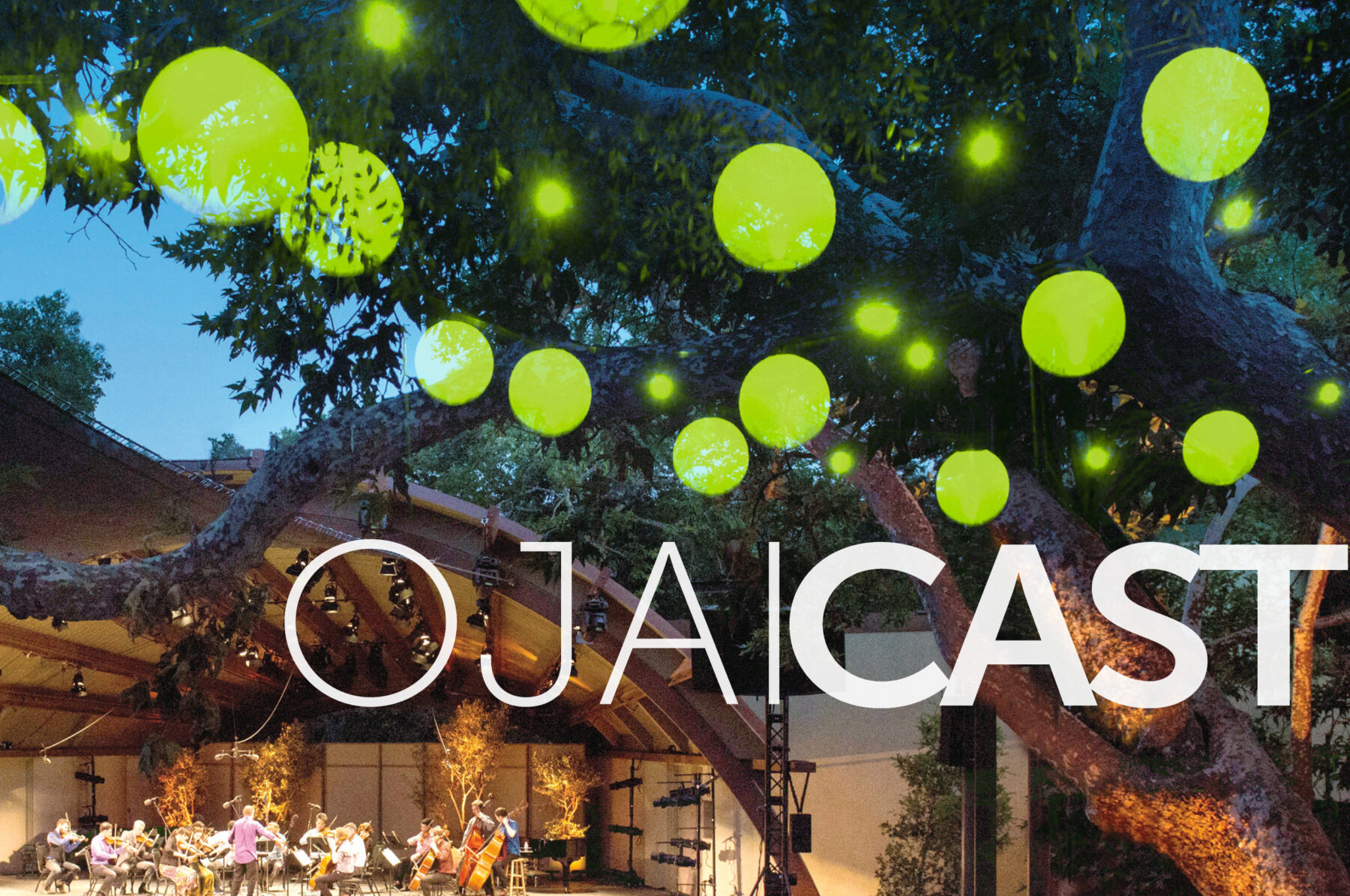
SEASON 3
Welcome to OJAICAST, where we pull back the curtain to take a sneak-peek at the upcoming Ojai Music Festival, June 8 to 11, in beautiful Ojai Valley, California. All are welcome here, from newcomers to long-time music fans. In-depth insights and special guests will help introduce this year’s programming and whet your musical appetites for what’s to come with host Emily Praetorius.
Episode 1
Our first episode gives an in-depth look into the 77th Ojai Music Festival (June 8 – 11, 2023), curated by Music Director Rhiannon Giddens. Special guest Artistic and Executive Director Ara Guzelimian will give us some insights into the creation of this year’s festival programming and background on some of pieces being played.
Ojai Virtual Talks, Rhiannon Giddens
Uncovering the History of the Banjo with Rhiannon Giddens
Emily Praetorius, host and producer
Louis Ng, recording engineer
OJAICast theme by Thomas Kotcheff and Louis Weeks
Music Excerpts in this Episode:
I’m on My Way – Rhiannon Giddens
Performed by Rhiannon Giddens and Francesco Turrisi
Liquid Borders – Gabriela Ortiz
Performed by red fish blue fish
Clock Catcher – Flying Lotus
Performed by Attacca Quartet
Ghost Opera – Tan Dun
Performed by Kronos Quartet
Episode 2
Our second episode takes a look at the idea of composing across boundaries with 2023 Festival composers Niloufar Nourbakhsh and Carlos Simon.
Shawn Okpebholo
Ojai Virtual Talks: Lei Liang and Steve Schick
Niloufar Nourbakhsh and IFCA
Carlos Simon, Requiem for the Enslaved
Bill Traylor
Emily Praetorius, host and producer
Louis Ng, recording engineer
OJAICast theme by Thomas Kotcheff and Louis Weeks
Music Excerpts in this Episode:
mi sueño: afro-flamenco – Shawn Okpebholo
Performed by Clare Longendyke
The Willows are New – Chou Wen-Chung
Performed by Gloria Cheng
Veiled – Niloufar Nourbakhsh
Performed by Amanda Gookin
Between Worlds – Carlos Simon
Performed by Julia Mirzoev
Episode 3
Our final episode welcomes kamancheh player Niloufar Shiri, pipa player Wu Man, and multi-instrumentalist Francesco Turrisi to the podcast, where they discuss the history of their instruments, how they are played in contemporary music today, and what we can look forward to in this year’s Festival programming.
Niloufar Shiri Performs at Ojai Meadows Preserve
Niloufar Shiri
Pop Up Pipa with Wu Man
Francesco Turrisi: Playlist & Ojai Talk
Francesco Turrisi
Rhiannon Giddens and Francesco Turrisi Met Museum Concert
Emily Praetorius, host and producer
Louis Ng, recording engineer
OJAICast theme by Thomas Kotcheff and Louis Weeks
Music Excerpts in this Episode:
Niloufar Shiri Improvisation
Rhiannon Giddens and Francesco Turrisi Met Museum Concert
Also available on SPOTIFY and APPLE PODCASTS
OJAICast SEASON 2
OJAICast SEASON 1
ABOUT OUR OJAICAST HOST
Emily Praetorius, former Ojai Music Festival intern and Rothenberg Intern Fellow, is a current Composition DMA candidate at Columbia University. She previously studied composition and clarinet performance at the University of Redlands (BM) and composition at Manhattan School of Music (MM). She has studied with Kathryn Nevin (clarinet), Susan Botti, Georg Friedrich Haas, George Lewis, and Anthony Suter. Emily is from Ojai, CA and lives in New York City where she is a proud co-owner of Kuro Kirin Espresso & Coffee.
Thank you for your interest in the 2023 Ojai Music Festival!

A hallmark of groundbreaking musical experiences in idyllic Ojai, we welcome Grammy-winning Rhiannon Giddens to lead the 77th edition of our annual Festival. The four-day event includes Omar’s Journey based on Gidden’s new opera Omar and Carlos Simon’s Between Worlds inspired by the works of painter Bill Traylor. Get 15% off tickets when you enter the code CAAM15 at checkout.
DISCOUNT INFORMATION AND LIMITATIONS:
The CAAM15 discount code has a 2-ticket minimum and only applies to 2023 Ojai Music Festival tickets. The code will expire on June 12, 2023. Discount codes cannot be applied to ticket orders that have already been purchased. All ticket orders are non-refundable. If you can’t attend a concert, contact the Box Office at least 24 hours prior to the concert start time to turn your tickets into a donation. Contact the Box Office for any other questions or concerns.
Box Ofice:
Open 10 am – 5 pm, Monday – Friday
[email protected]
805 646 2053
Music Sounds Better in Ojai Winner Announced!
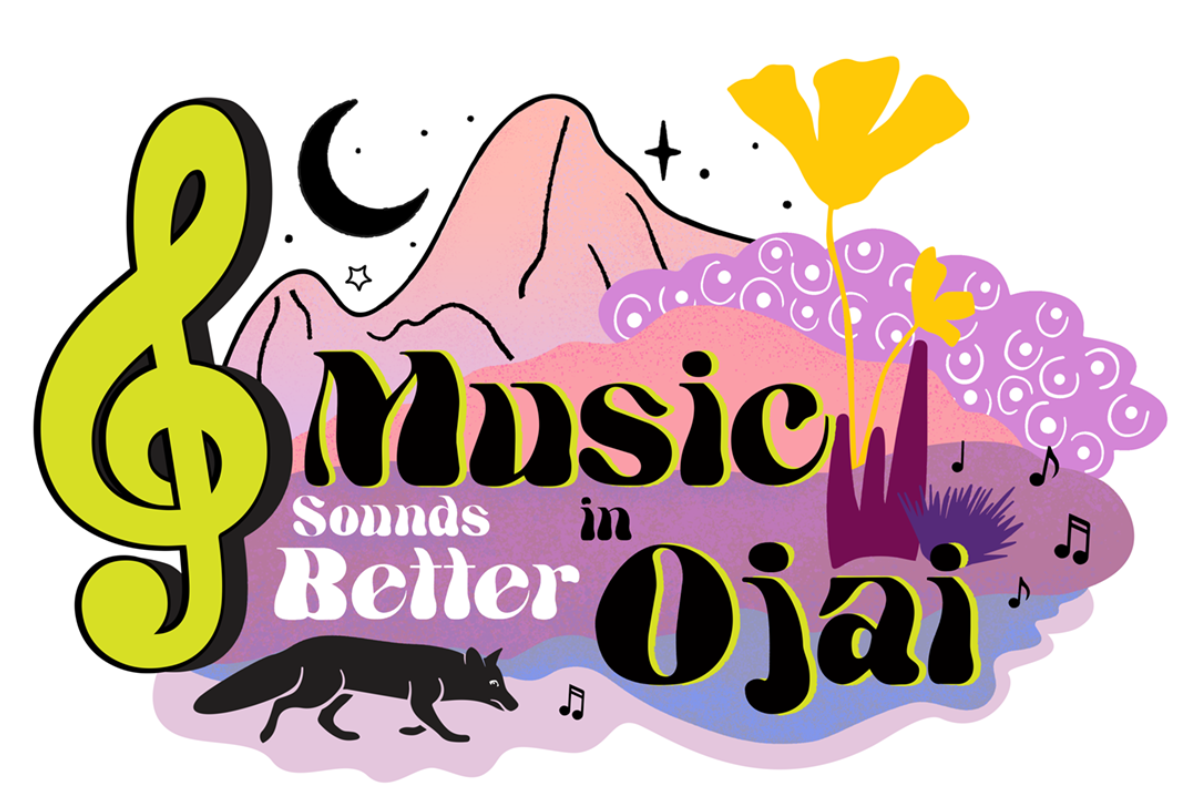
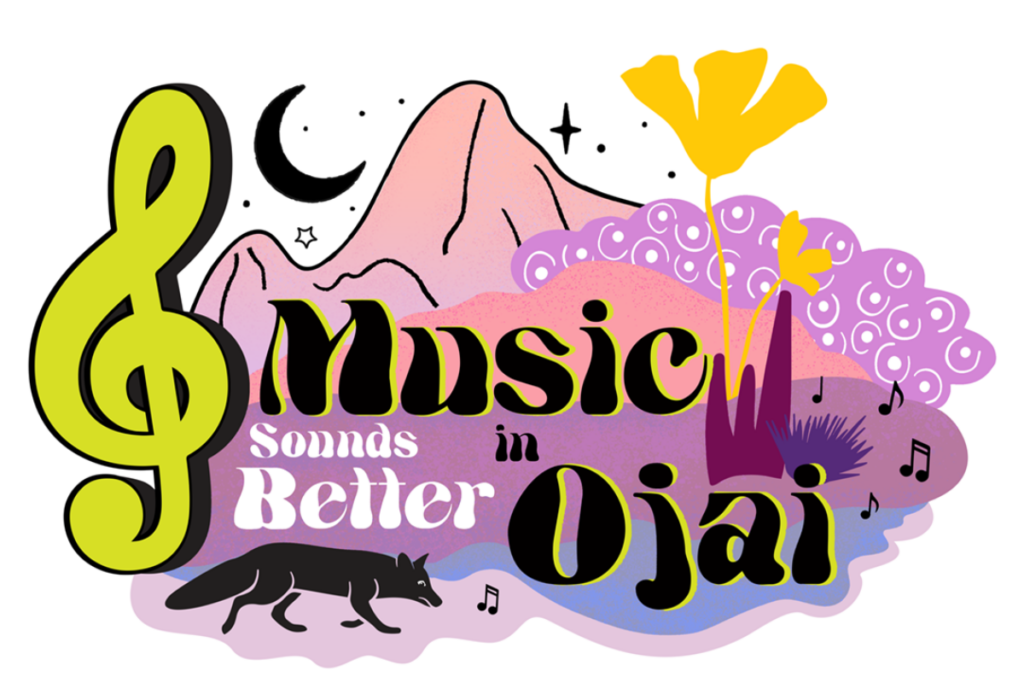
And the winner is Jules Weismann for our Design Challenge!
Thanks to the participants for submitting their artwork to our design challenge and to the panelists for helping us select the winning design.
We appreciated the heartfelt and imaginative spirit of all the designers, and we landed with our favorite by Ojai artist Jules Weismann.
About Jules Weismann
Jules Weissman works with digital and multimedia mediums to explore themes of identity and connection. With a background in graphic design and a love for experimentation, she often finds her inspiration in Ojai, where she lives with the oldest cat in the world.
View some of our honorable mentions from other designers:
Look for new limited edition merchandise with some of these designs at the upcoming June Festival!
2023 Music Director Rhiannon Giddens and Artistic Director Ara Guzelimian Share Updates to the 77th Ojai Music Festival
“I am so excited to get to work with the Ojai Music Festival as Music Director for 2023. With Ojai, I am able to sit at the crossroads of all that I am artistically and feel fully supported by the Festival team and by Ojai’s audiences. With the artists that we’re bringing out next June, the future is in celebration of how we come together as humans – despite boxes, boundaries, and borders thrown up with the intent to keep us apart.” – Rhiannon Giddens, 2023 Ojai Festival Music Director
Ojai welcomes guest artists to the 2023 Festival, including Wu Man (pipa), Kayhan Kalhor (kamancheh/composer), 2015 Ojai Music Director Steven Schick (conductor/percussion), Francesco Turrisi (multi-instrumentalist), Seckou Keita (kora), Gloria Cheng (piano), Emi Ferguson (flute), Justin Robinson (fiddle), Michi Wiancko (violin), and Leonard Hayes (piano); featured singers Cheryse McLeod Lewis (mezzo-soprano), Limmie Pulliam (tenor), and Michael Preacely (bass-baritone); guest ensembles Attacca Quartet, red fish blue fish (percussion), and members of the Silkroad Ensemble: Mazz Swift (violin), Mario Gotoh (violin/viola), Karen Ouzounian (cello), and Shawn Conley (double bass)
Highlights of the 2023 Festival programming:
• The Festival opens with Gabriela Ortiz’s Liquid Borders performed by red fish blue fish directed by Steven Schick alongside the Attacca Quartet in works of John Adams, Flying Lotus, Rhiannon Giddens, Philip Glass, Haydn, Kayhan Kalhor, and Squarepusher
• World Premiere of Omar’s Journey, an Ojai commissioned suite for voices and chamber ensemble drawn from the opera Omar by Rhiannon Giddens and Michael Abels with Giddens (soprano) singing the role of Julie. The new work, placed in the context of the journey of Omar Ibn Said (1770-1864), is contextualized by the music of Senegal and the Carolinas
• World Premiere of an Ojai Music Festival commission by Aida Shirazi, founding member of the Iranian Female Composers Association (IFCA), for kamancheh and electronics; and Festival-wide programming in honor of the IFCA with works by Niloufar Nourbaksh, Nina Barzegar, Nasim Khorassani, and Golfam Khayam
• A reimagining of Tan Dun’s pioneering Ghost Opera for pipa and string quartet with Wu Man, Attacca Quartet, PeiJu Chien-Pott (dancer/choreographer), and Jon Reimer (director)
• An acoustic concert with Rhiannon Giddens and Francesco Turrisi with music ranging from the Baroque to Appalachian ballads and traditional Black American songs as well as excerpts from Songs of Flight by Shawn Okpebholo
• Carlos Simon’s Between Worlds, four solo string works placed in visual context by their source of inspiration: the paintings of self-taught artist Bill Traylor (1853-1949) whose lived experience spanned the Civil War, Emancipation, Reconstruction, Jim Crow, and the Great Migration
• An “Early Music” concert curated by Francesco Turrisi with music spanning from ancient pipa music to works of Dowland and Monteverdi
• “Strings Attached” concert – a festive finale of string instruments from cultures across the Americas, Asia, Europe, and the Middle East
• Activities designed to welcome and engage the community throughout the Festival include four free events – two early morning concerts with Niloufar Shiri (kamancheh) and Mario Gotoh (violin), and with Seckou Keita (kora); an interactive community concert performance of Elliot Cole’s Flowerpot Music led by Steven Schick; and a reading/musical performance by Rhiannon Giddens of her new children’s book Build a House
Additional works featured throughout the Festival by Margaret Bonds, Chou Wen-chung, Tyson Gholston Davis, Ge Gan-Ru, Lei Liang, Jessie Montgomery, Shawn Okpebholo, and Edgard Varèse
OJAI, California — March 15, 2023— The 77th Ojai Music Festival, June 8 to 11, 2023, welcomes acclaimed musician and composer Rhiannon Gidden as Music Director. Along with Festival Artistic Director Ara Guzelimian, Giddens shares additional details for the upcoming Festival which will include more than 20 music events in the beautiful setting of the Ojai Valley.
“Rhiannon Giddens has an extraordinarily wide embrace of music, history, and culture. She uses her art to tell essential stories, to illuminate, and to create deeper understanding, dissolving false boundaries between people and cultures,” adds Guzelimian. “Rhiannon’s programs for the 2023 Ojai Festival touch on so many of her interests across musical genres, from Baroque music to Black traditions in American roots music, from classical music from China and Persia to the influence of non-Western music on American contemporary works. This is a Festival that celebrates liquid borders between cultures and musics, so we appropriately begin the programming with Gabriela Ortiz’s work of the same name. I am thrilled to be working with all our 2023 Festival artists and with Rhiannon as we bring her range of musical interests to Ojai audiences.”
One of the 2023 Festival program anchors will be Omar’s Journey, an Ojai-commissioned suite for voices and small chamber ensemble drawn from the recently premiered and widely acclaimed opera Omar by Rhiannon Giddens and Michael Abels. For Ojai, this intimate concert version of Omar will be placed in the context of the journey of Omar Ibn Said (1770-1864), a Muslim scholar who was captured from his native Senegal and enslaved in North and South Carolina. Omar’s Journey will pair the new Giddens/Abels suite with the musical traditions of Senegal and the Carolinas of his lifetime. This world premiere features Giddens, soprano, singing the role of Julie for the first time, joined by Cheryse McLeod-Lewis (mezzo-soprano), Limmie Pulliam (tenor), and Michael Preacely (bass-baritone).
During this 77th edition of the Ojai Festival, additional music centerpieces include a reimagining of Tan Dun’s pioneering Ghost Opera performed by Wu Man and Attacca Quartet. Written in 1994, Tan’s Ghost Opera evokes the spirits of Bach and Shakespeare, standing with the ancient folk traditions of traditional shamanistic Chinese music. Ojai’s reimagined performance of Tan’s work is directed by Jon Reimer with dancer/choreographer PeiJu Chien-Pott.
Gabriela Ortiz’s Liquid Borders performed by red fish blue fish directed by Steven Schick opens the Festival. Liquid Borders will be followed by works of John Adams, Flying Lotus, Rhiannon Giddens, Philip Glass, Haydn, Kayhan Kalhor, and Squarepusher curated and performed by the Attacca Quartet.
A complete performance of Carlos Simon’s Between Worlds, a quartet of string works placed directly in the visual context of the art of Bill Traylor (1853-1949), will be performed by members of the Silkroad Ensemble – Mazz Swift, Mario Gotoh, Karen Ouzounian, and Shawn Conley – with projection mapping by Ross Karre. Traylor’s lived experience spanned the Civil War, Emancipation, Reconstruction, Jim Crow and the Great Migration. Carlos Simon wrote, “Themes of mystical folklore, race, and religion pervade Traylor’s work. I imagine these solo pieces as a musical study; hopefully showing Traylor’s life between disparate worlds.”
The Saturday morning concert, “The Willows are New,” celebrates a range of works by Niloufar Nourbakhsh, one of the founding members of the Iranian Female Composers Association (IFCA), Lei Liang, Ge Gan-Ru, and Chou Wen-chung followed by solo improvisations by renowned kamancheh player Kayhan Kalhor.
Ojai’s “Early Music” concert on Sunday, June 11, curated by Francesco Turrisi, plays on the idea of “old music and on music for the first hours of the day.” Turrisi’s program celebrates thousand-year-old works for solo pipa, to Renaissance consort music, from ancient Persian melodies to modal jazz improvisations.
The 2023 Festival concludes with an exuberant musical summit performed by Rhiannon Giddens, Wu Man, Kayhan Kalhor, Seckou Keita, Justin Robinson, Francesco Turrisi, Michi Wiancko, and members of the Silkroad Ensemble – Mario Gotoh, Karen Ouzounian, Mazz Swift, and Shawn Conley. This family jam session “Strings Attached” features solos and collaborations among the bowed and plucked string instruments from cultures across the Americas, Asia, Europe, and the Middle East.
In honor of what would have been his 100th birthday, the Festival will feature works of Chinese American composer Chou Wen-chung coupled with the music of Edgard Varèse who was Chou’s mentor. The Festival will also present music by Michael Abels, John Adams, Nina Barzegar, Margaret Bonds, Tyson Gholston Davis, Flying Lotus, Ge Gan-Ru, Rhiannon Giddens, Philip Glass, Kayhan Kalhor, Golfam Khayam, Nasim Khorassani, Lei Liang, Jessie Montgomery, Niloufar Nourbakhsh, Shawn Okpebholo, and Caroline Shaw.
2023 Featured Artists
Rhiannon Giddens’ 2023 collaborators include a mix of Festival debuts and returning artists. Audiences will be introduced to Leonard Hayes (piano), Kayhan Kalhor (kamancheh/composer), Seckou Keita (kora), Justin Robinson (fiddle), Michi Wiancko (violin), members of the Silkroad Ensemble including Mazz Swift (violin), Mario Gotoh (violin/viola), Karen Ouzounian (cello), and Shawn Conley (double bass), and singers Cheryse McLeod-Lewis (mezzo-soprano), Limmie Pulliam (tenor), and Michael Preacely (bass-baritone).
Making welcome returns to Ojai will be percussionist/conductor Steven Schick, Music Director for the 2015 Festival, and pipa player Wu Man who last appeared with Schick. From the 2021 Festival will be multi-instrumentalist Francesco Turrisi, Emi Ferguson (flute), and the Attacca Quartet (violinists Amy Schroeder and Domenic Salerni, violist Nathan Schram, and cellist Andrew Yee), as well as Gloria Cheng (piano) and red fish blue fish (percussion ensemble), both last seen at the 2015 Festival.
Community Offerings
An integral part of the immersive Ojai Festival experience are the free community activities that occur in the Libbey Park and throughout Ojai. The 2023 Festival will include two morning Meditations at Chaparral Auditorium, the first begins Saturday, June 10 with Niloufar Shiri, kamancheh and Mario Gotoh, violin. On Sunday, June 11 the Morning Meditation features Seckou Keita, kora.
Percussionist/conductor Steven Schick welcomes everyone to make music together in the Libbey Park on Sunday afternoon. Led by Schick, the Ojai community and patrons will be invited to participate in an interactive performance of Elliot Cole’s Flowerpot Music.
On the same Sunday afternoon at Libbey Park, Rhiannon Giddens offers a special family event for children of all ages. Giddens will do a reading and musical performance of her debut book Build a House. The picture book, published by Candlewick Press, was inspired by a song that Giddens wrote and recorded with Yo-Yo Ma to commemorate Juneteenth 2020.
Beyond Ojai: Online Offerings
The Ojai Music Festival lives beyond the flagship four-day festival in June, allowing further engagement with audiences worldwide. These include the Festival’s state-of-the-art live streaming and archived library of concerts; Virtual Ojai Talks with featured Festival artists and alum leading up to the Festival; and OjaiCAST, the podcast series that provides insights on upcoming programming. The Festival’s digital projects are available at OjaiFestival.org.
Ojai on the Air with WQXR/New Sounds with host John Schaefer continues this year. The series of programs connects audiences and artists who engage deeply with adventurous new music. The first program, which debuted in October 2022 and is archived and available at NewSounds.org (episodes 4668-4671) featured discipline colliding collective AMOC, Ojai’s 2022 Music Director. Details of the second installment with 2023 Music Director Rhiannon Giddens will be announced soon. Sign up for the New Sounds newsletter to be informed of dates and about other musical adventures also at NewSounds.org.
Single Tickets for the 2023 Ojai Music Festival
Single Tickets are available and may be purchased at OjaiFestival.org or by calling (805) 646-2053. Single tickets range from $150 to $50 for reserved seating in the Libbey Bowl. General admission for the Lawn in Libbey Bowl is $20. Add-on event prices range from $35 to $50. Student discounts, OjaiNEXT young professional discounts, and group sales are available by inquiring with our Box Office.
RHIANNON GIDDENS, MUSIC DIRECTOR OF THE 2023 OJAI MUSIC FESTIVAL
The acclaimed musician Rhiannon Giddens uses her art to excavate the past and reveal bold truths about our present. A MacArthur “Genius Grant” recipient, Giddens co-founded the Grammy Award-winning Carolina Chocolate Drops. She most recently won a Grammy Award for Best Folk Album for They’re Calling Me Home and was also nominated for Best American Roots Song for “Avalon” from They’re Calling Me Home, which she made with multi-instrumentalist Francesco Turrisi. Giddens is now a two-time winner and eight-time Grammy nominee for her work as a soloist and collaborator.
They’re Calling Me Home was released by Nonesuch last April and has been widely celebrated by the NY Times, NPR Music, NPR, Rolling Stone, People, Associated Press and far beyond, with No Depression deeming it “a near perfect album…her finest work to date.” Recorded over six days in the early phase of the pandemic in a small studio outside of Dublin, Ireland – where both Giddens and Turrisi live – They’re Calling Me Home manages to effortlessly blend the music of their native and adoptive countries: America, Italy, and Ireland. The album speaks of the longing for the comfort of home as well as the metaphorical “call home” of death.
Giddens’ lifelong mission is to lift people whose contributions to American musical history have previously been erased, and to work toward a more accurate understanding of the country’s musical origins. Pitchfork has said of her work, “few artists are so fearless and so ravenous in their exploration,” and Smithsonian Magazine calls her “an electrifying artist who brings alive the memories of forgotten predecessors, white and black.”
Among her many diverse career highlights, Giddens has performed for the Obamas at the White House and received an inaugural Legacy of Americana Award from Nashville’s National Museum of African American History in partnership with the Americana Music Association. Her critical acclaim includes in-depth profiles by CBS Sunday Morning, the New York Times, the New Yorker, and NPR’s Fresh Air, among many others.
Giddens was featured in Ken Burns’ Country Music series, which aired on PBS, where she spoke about the African-American origins of country music. She is also a member of the band Our Native Daughters with three other black female banjo players, Leyla McCalla, Allison Russell, and Amythyst Kiah, and co- produced their debut album Songs of Our Native Daughters (2019), which tells stories of historic black womanhood and survival.
Giddens is in the midst of a tremendous 2022. She recently announced the publication of her first book, Build a House (October 2022). Lucy Negro Redux, the ballet Giddens wrote the music for, had its premiere at the Nashville Ballet (premiered in 2019 and toured in 2022), and the libretto and music for Giddens’ original opera, Omar, in collaboration with Michael Abels, based on the autobiography of the enslaved man Omar Ibn Said, premiered at the Spoleto USA Festival in May. Giddens is also curating a four-concert Perspectives series as part of Carnegie Hall’s 2022–2023 season. Named Artistic Director of Silkroad Ensemble in 2020, Giddens is developing new programs for that ensemble, including one inspired by the history of the American transcontinental railroad and the cultures and music of its builders. As an actor, Giddens had a featured role on the television series Nashville.
Rhiannon Giddens made her debut at the Ojai Music Festival in September 2021 with Music Director John Adams.
ARA GUZELIMIAN, ARTISTIC AND EXECUTIVE DIRECTOR
Ara Guzelimian is Artistic and Executive Director of the Ojai Music Festival, having begun in that position in July 2020. The appointment culminates many years of association with the Festival including tenures as director of the Ojai Talks and as Artistic Director from 1992–97. Guzelimian stepped down as Provost and Dean of the Juilliard School in New York City in June 2020, having served in that position since 2007. At Juilliard, he worked closely with the president in overseeing the faculty, curriculum, and artistic planning of the distinguished performing arts conservatory in all three of its divisions: dance, drama, and music. He continues at Juilliard as Special Advisor, Office of the President.
Prior to the Juilliard appointment, he was Senior Director and Artistic Advisor of Carnegie Hall from 1998 to 2006. Guzelimian serves as artistic consultant for the Marlboro Music Festival and School in Vermont. He is a member of the steering committee of the Aga Khan Music Awards, the artistic committee of the Borletti-Buitoni Trust in London, and a board member of the Amphion and Pacific Harmony Foundations. He is also a member of the music visiting committee of the Morgan Library and Museum in New York City. In 2020, Guzelimian was appointed to the advisory panel of the Birgit Nilsson Foundation in Sweden.
Previously, Guzelimian held the position of Artistic Administrator of the Aspen Music Festival and School in Colorado, and he was long associated with the Los Angeles Philharmonic at the beginning of his career, first as producer for the orchestra’s national radio broadcasts and, subsequently, as Artistic Administrator. Guzelimian is editor of Parallels and Paradoxes: Explorations in Music and Society (Pantheon Books, 2002), a collection of dialogues between Daniel Barenboim and Edward Said. In September 2003, he was awarded the title Chevalier des Arts et des Lettres by the French government for his contributions to French music and culture.
OJAI MUSIC FESTIVAL
The Ojai Music Festival represents an ideal of adventurous, openminded, and openhearted programming in the most beautiful and welcoming of settings, with audiences and artists to match its aspirations. Marking its 75th anniversary season last year, the Festival remains a creative laboratory for thought-provoking musical experiences, bringing together innovative artists and curious audiences in an intimate, idyllic outdoor setting. Each Festival’s narrative is guided by a different Music Director, whose distinctive perspectives shape programming — ensuring energized festivals year after year.
Throughout each year, the Ojai Music Festival contributes to Southern California’s cultural landscape with in-person and online Festival-related programming as well as robust educational offerings that serve thousands of public-school students and seniors. The organization’s apex is the world-renowned four-day Festival, which takes place in Ojai, a breathtaking valley 75 miles from Los Angeles, which is a perennial platform for the fresh and unexpected. During the immersive experience, a mingling of the most curious take part in concerts, symposia, free community events, and social gatherings. During the intimate Festival weekend, considered a highlight of the international music summer season, Ojai welcomes up to 5,000 patrons and reaches 35 times more audiences worldwide through live and on- demand streaming of concerts and discussions throughout the year.
Since its founding in 1947, the Ojai Music Festival has presented broad-ranging programs in unusual ways with an eclectic mix of new and rarely performed music, as well as refreshing juxtapositions of musical styles. Through its signature structure of the Artistic Director appointing a different Music Director each year, Ojai has presented a “who’s who” of music including the multi-disciplinary colliding collective AMOC* (American Modern Opera Company), Vijay Iyer, Patricia Kopatchinskaja, and Barbara Hannigan in recent years; throughout its history, featured artists have included Aaron Copland, Igor Stravinsky, Michael Tilson Thomas, Kent Nagano, Pierre Boulez, John Adams, Esa-Pekka Salonen, Robert Spano, Pierre-Laurent Aimard, David Robertson, Eighth Blackbird, George Benjamin, Dawn Upshaw, Leif Ove Andsnes, Mark Morris, Jeremy Denk, Steven Schick, Matthias Pintscher, and Peter Sellars.
Press contacts:
Ojai Music Festival: Gina Gutierrez, [email protected] (805) 646-2181 National/International: Nikki Scandalios, [email protected] (704) 340-4094
In the Life of an Intern
by Landon Wilson, Manhattan School of Music, Ojai Alumnus 2022
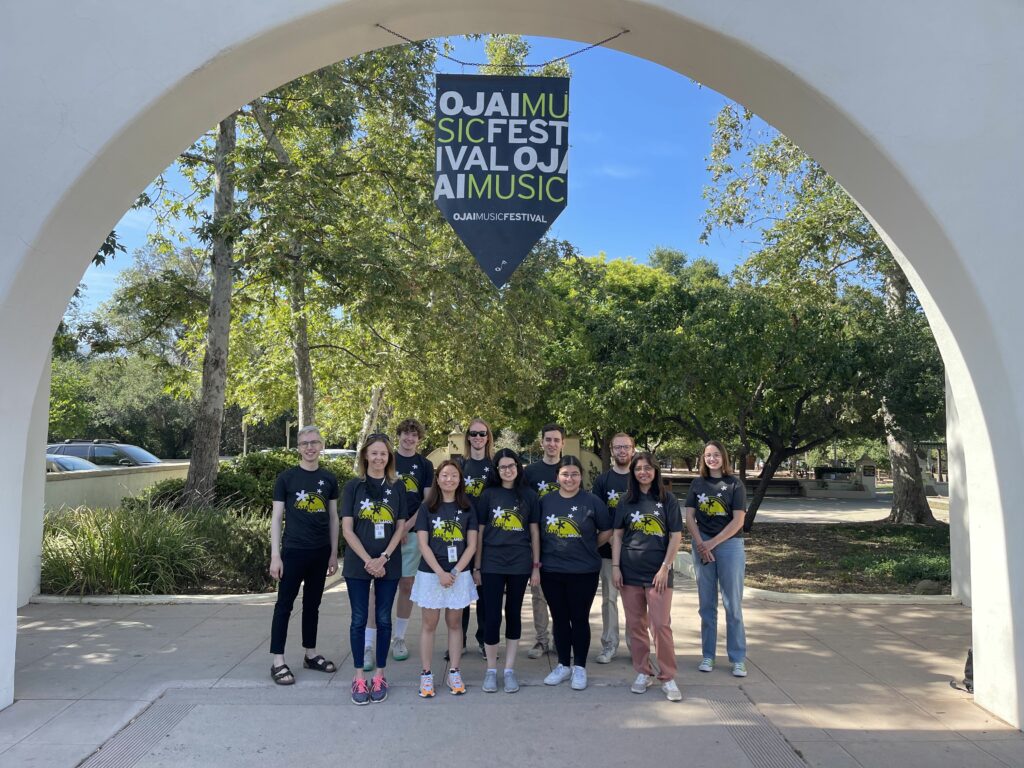
The Ojai Music Festival’s Arts Management Internship Program is entering its 15th year of providing career opportunities for young stewards of boundary-bending music. Our internship program supports college students from a variety of fields and interests. From production, to the box office, to marketing, to technology, interns have become a vital part of what makes the Festival happen each year, finding themselves deeply entwined in every department.
This article follows Landon Wilson’s story of his time as one of our 15 Arts Management Interns for the 2022 Festival. Landon was Managing Director Gina Gutierrez’s right-hand-intern working in areas of social media, marketing and press relations, but as you will read, this role involves much more! Since the internship in June 2022, Landon has been able to utilize the skills developed at the Ojai Music Festival as the Artistic Associate for AMOC*, while completing a degree at the Manhattan School of Music.
Introduction by Madeline Grass Doss, Patron Services & Office Administrator, Ojai Alumna 2021
Arriving in Ojai
It was day one in SoCal! After touching down at LAX, a few other interns and I made our way up the Pacific Coast Highway to meet the Festival’s Intern Coordinator, Laura Walter, who showed us around palm-lined Ojai Ave upon arriving in town.
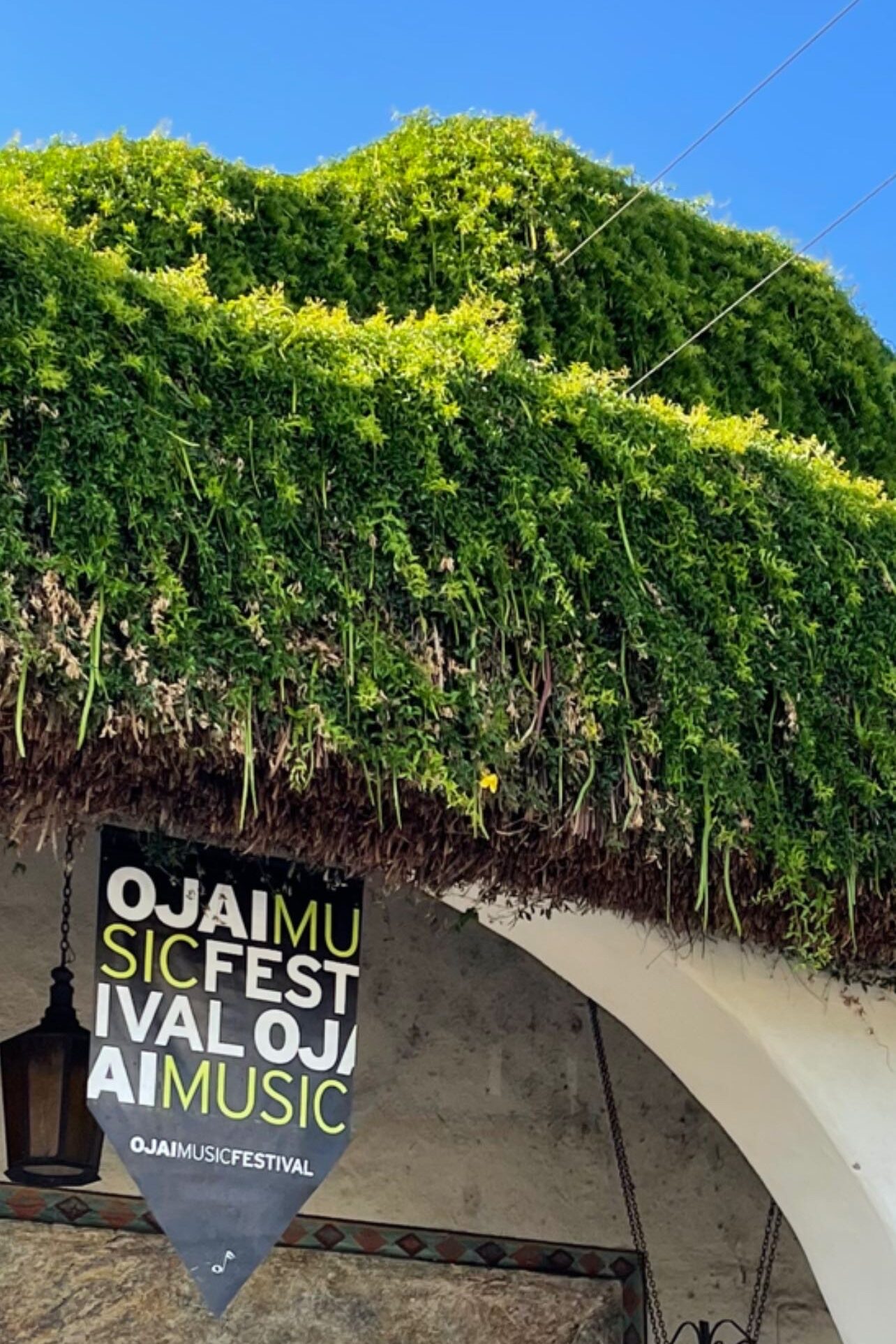
We settled into our homestays at the Taormina Theosophical Institute and met up with the other interns for a welcome dinner at Jim and Rob’s Fresh Grill. This was a wonderful moment for us to get to know one another. Like me, many interns had traveled across the country to spend a few weeks working in picturesque Ojai!
Getting Acquainted
The next day, the internship program kicked off with a breakfast hosted by Festival leadership and staff. This included meeting my fabulous mentor, Gina Gutierrez. (the Festival’s Managing Director), who would guide my time in Ojai as the Marketing and Social Media Intern. We immediately jumped into preparing a social media and communications calendar and discussing creative ways to promote the Festival’s 18 events with Music Director AMOC* (American Modern Opera Company). Gina encouraged me to explore Ojai and use the liminal time to capture content.
In this spirit, many of the interns and I took advantage of this short opportunity for downtime before the Festival to discover greater Ojai. This included locals taking us on thoughtful guided tours of the Ojai Valley Museum, hiking trails, and even the Ojai Olive Oil Company, where we had a delicious afternoon tasting their 50+ varieties. A personal highlight was spending some time browsing a quintessential Ojai spot—Bart’s Books.
The energy in the Festival office was palpable as more staff arrived. The iconic green lanterns began to appear across the street in Libbey Park, signifying the town’s overnight transformation from an idyllic bohemian getaway to the center of the classical music world! Much to my delight, it soon became apparent that I would be able to diversify my experience and work across departments, often with Mary Ann Makee with the Front of House staff, and with Producer Fiona Digney with the production team.
It was during this time that I also met AMOC* whose 17 members could be found in the Libbey Bowl and across Ojai in rehearsals. They would occasionally pop their heads into the office, adding to the kinetic energy in the air that made me all the more excited to develop the marketing materials with Gina. The start of the Festival was rapidly approaching!
“Unique mentorship experiences with the Festival’s staff allowed me to explore different facets of the industry and deepen my commitment to further developing as a well-rounded arts administrator.”
—LANDON WILSON, Manhattan School of Music, Ojai Alumnus 2022
Ojai Runs AMOC*: the 76th Festival Weekend
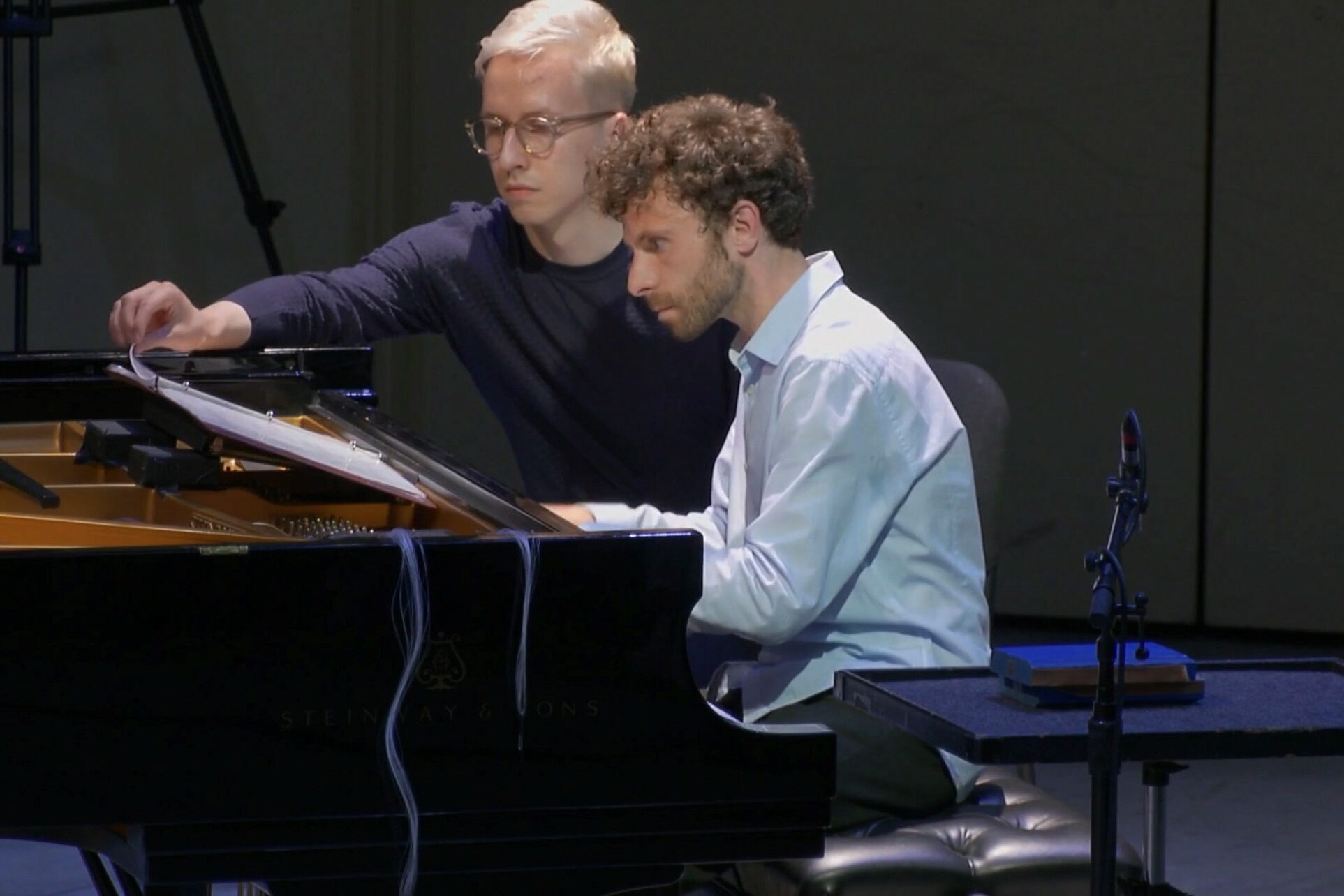
The Festival was finally here! Being used to navigating my home base NYC on foot, I loved starting the day with an early-morning walk to the office with an avocado toast and pistachio rose latte (shoutout to Café BōKU!) before beginning the busy work day ahead. Upon arriving at the office, I got a call from Fiona asking me to turn pages for a rehearsal in Libbey Bowl, which led to me sitting on stage with AMOC* for three performances! Gina and I regrouped at lunch and developed a plan for the rest of the day, which included meeting with the Festival’s publicist to prepare press packets for the visiting media and attending several performances and world premieres.
As the weekend progressed, Ojai seemed to be teeming with increasing anticipation for each concert. The Festival featured many afternoon performances in the Libbey Bowl, where I worked with the unflappable Front of House staff and interns as an usher, getting to welcome the loyal and enthusiastic patrons of the Ojai Music Festival. I was always surprised to see who was mingling between concerts, whether it be composer John Adams or architect Frank Gehry, everyone brought an appetite for curiosity to discover new musical ideas.
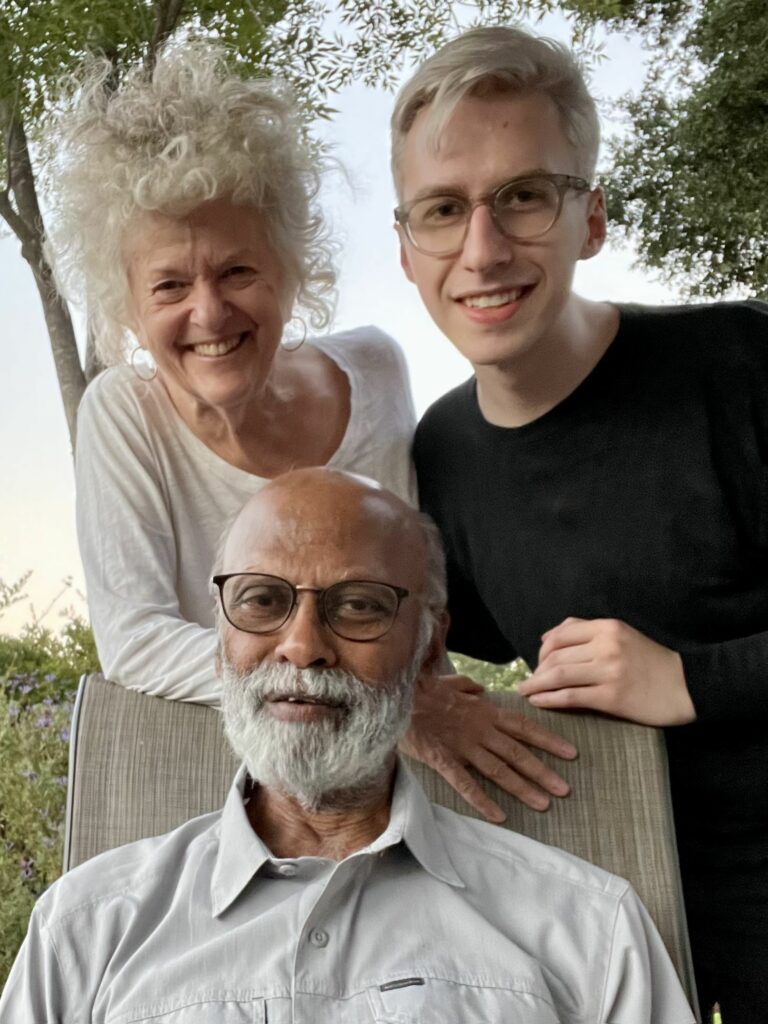
The Festival culminated with a rousing finale concert, featuring all of AMOC* and a particularly catchy Julius Eastman tune that embodied the mood of the Festival and my experience as an intern. Rewatch that last concert here, and you’ll know what I mean!
Host Family
The internship ended as quickly as it began. It was time to say goodbye to the Festival team, my new intern friends, and my lovely hosts. The Dierdre Daly connected me with a wonderful couple from NYC that had relocated to Ojai during the pandemic. Carol, Anan, and their sweet dog Anbu were incredibly welcoming hosts that attended many of the performances, making for stirring evening conversations and my time in Ojai all the more enjoyable.
Looking Forward
I don’t think a day has passed since last June that I haven’t reminisced on my time in Ojai. Interning with the Festival was a whirlwind two weeks of immersive learning opportunities that helped shape my professional aspirations. Unique mentorship experiences with the Festival’s staff allowed me to explore different facets of the industry and deepen my commitment to further developing as a well-rounded arts administrator. I can’t wait to return this June for the 77th Ojai Music Festival!
More content captured by Landon
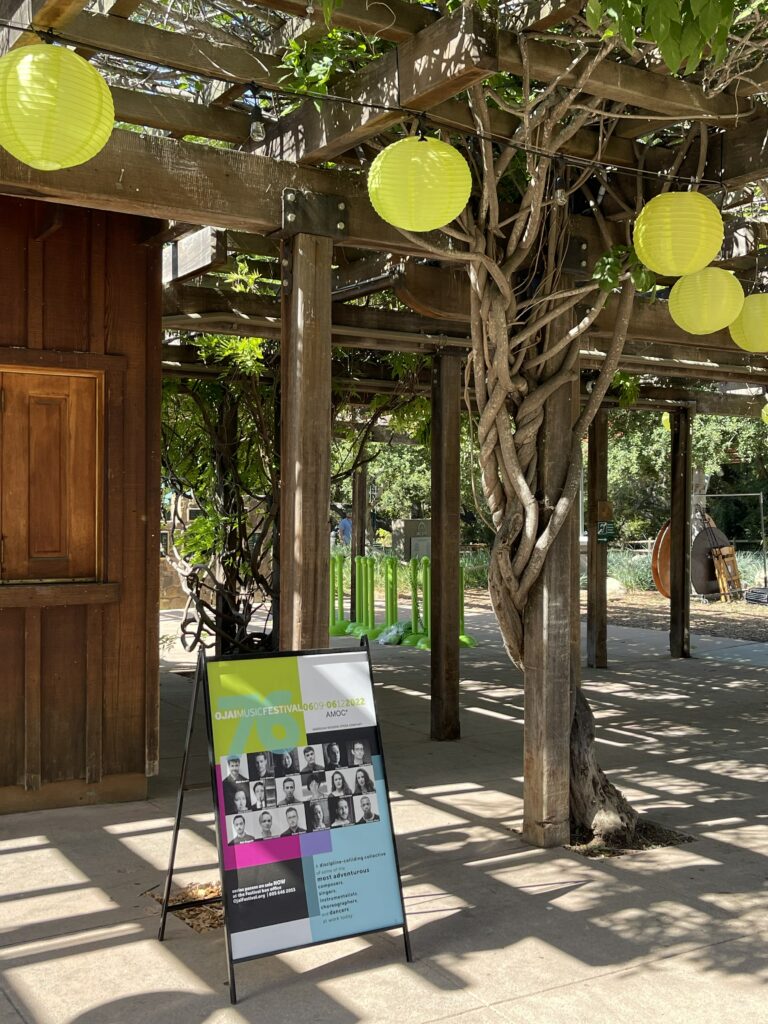
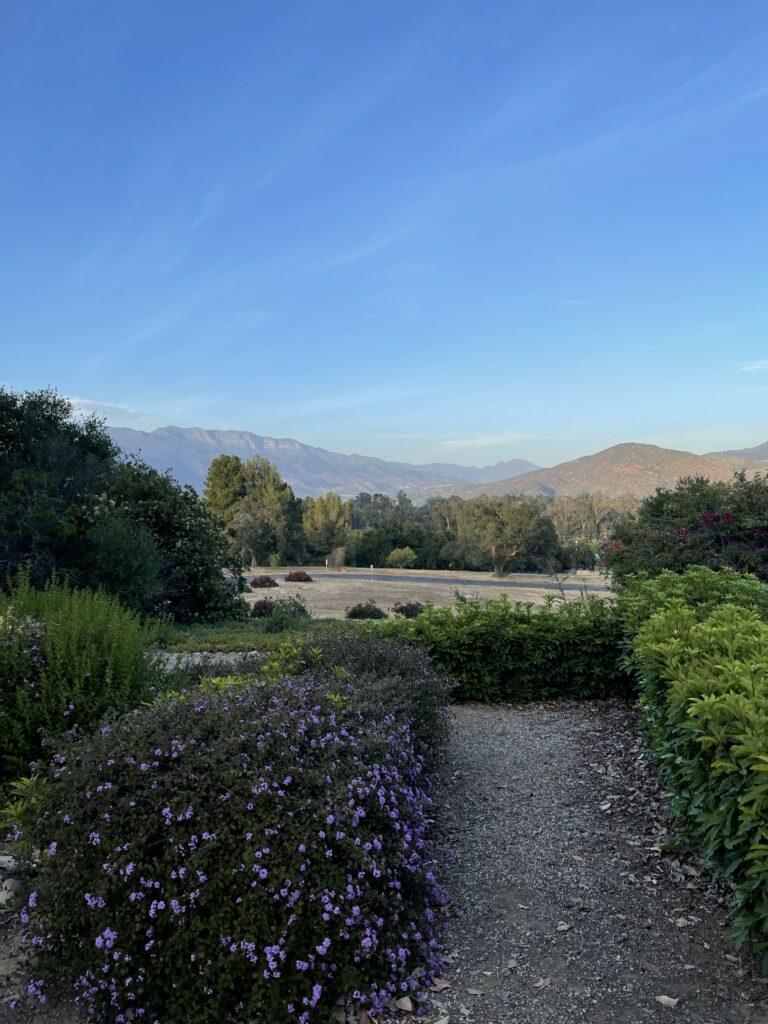
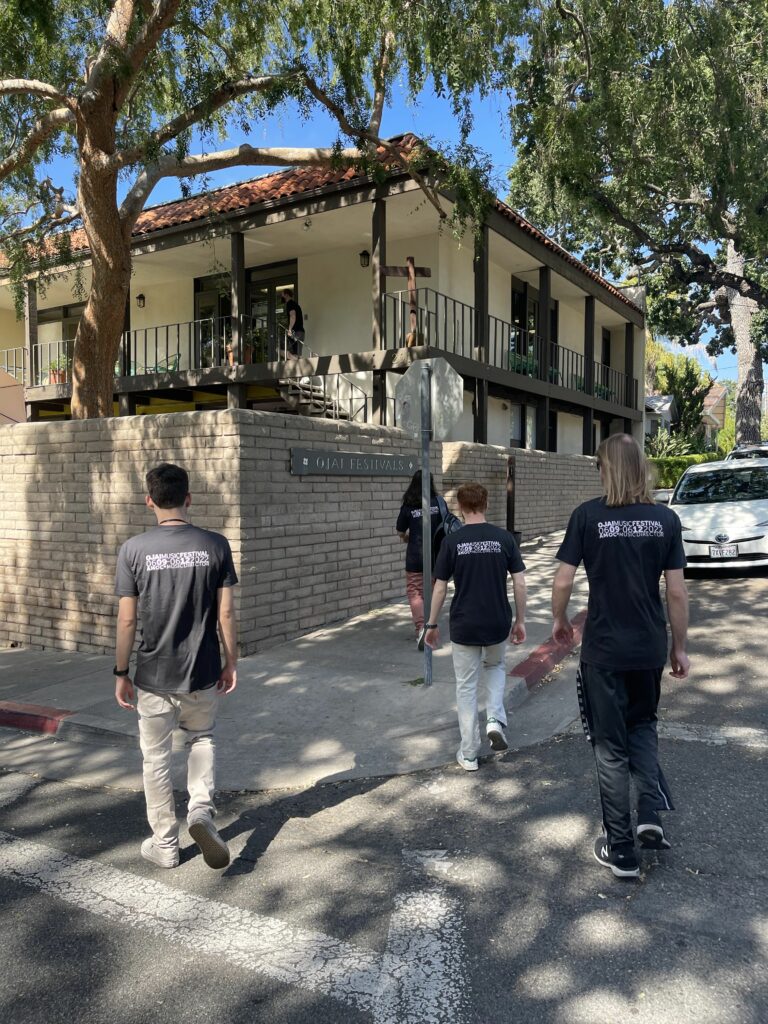
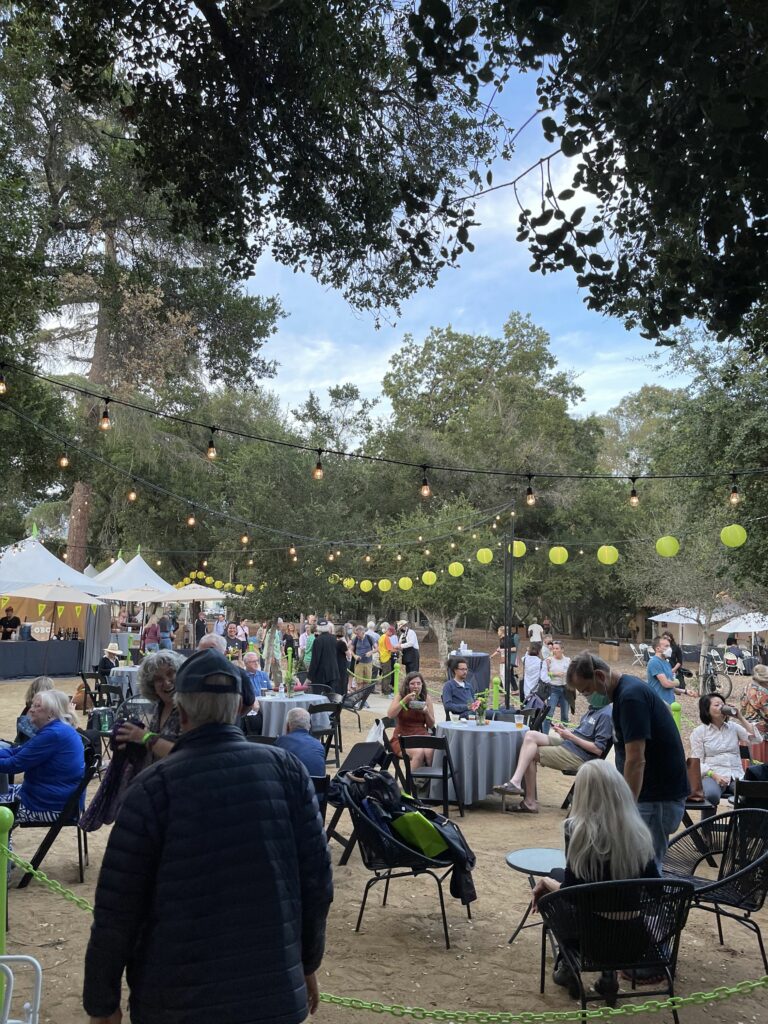
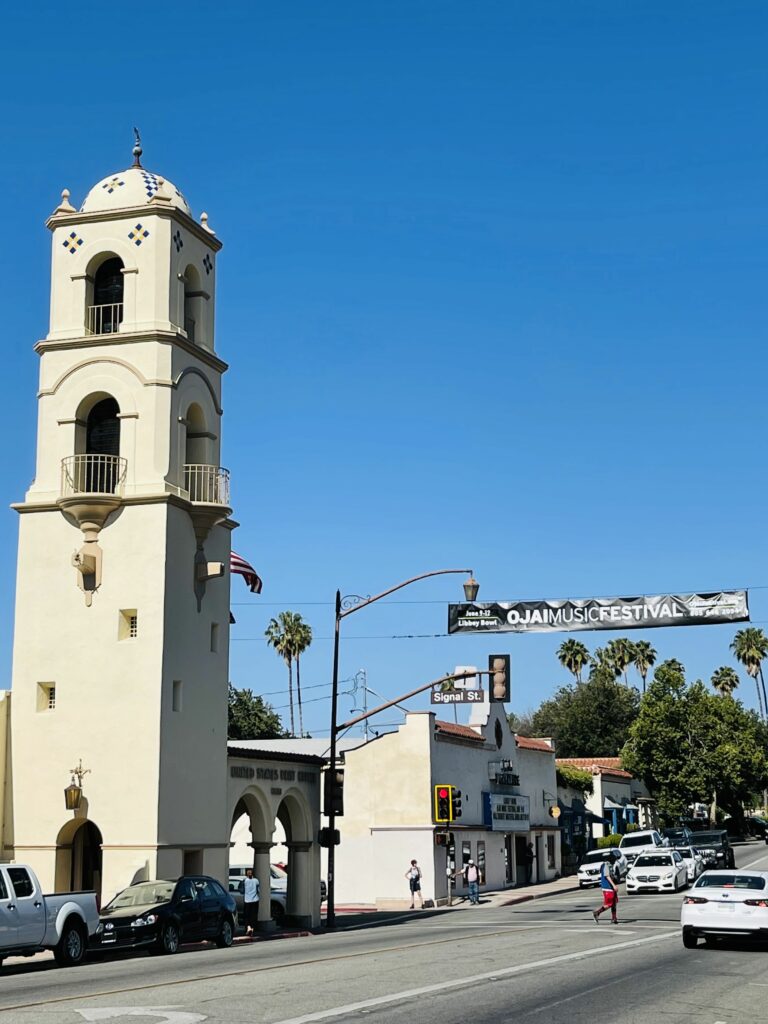
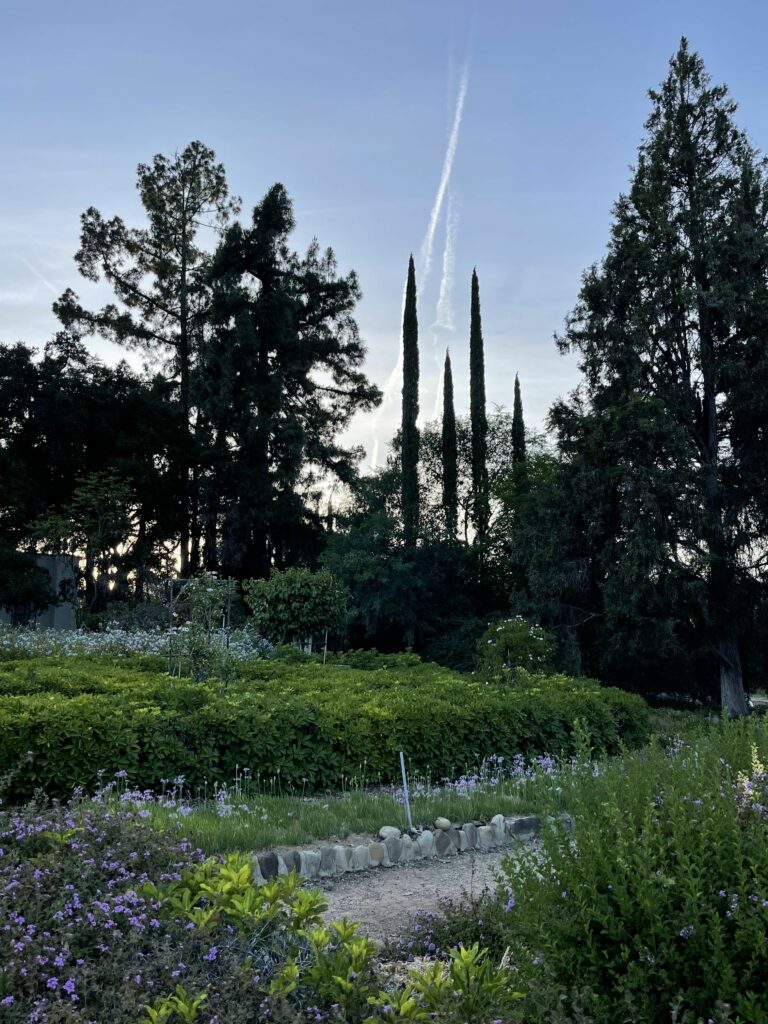
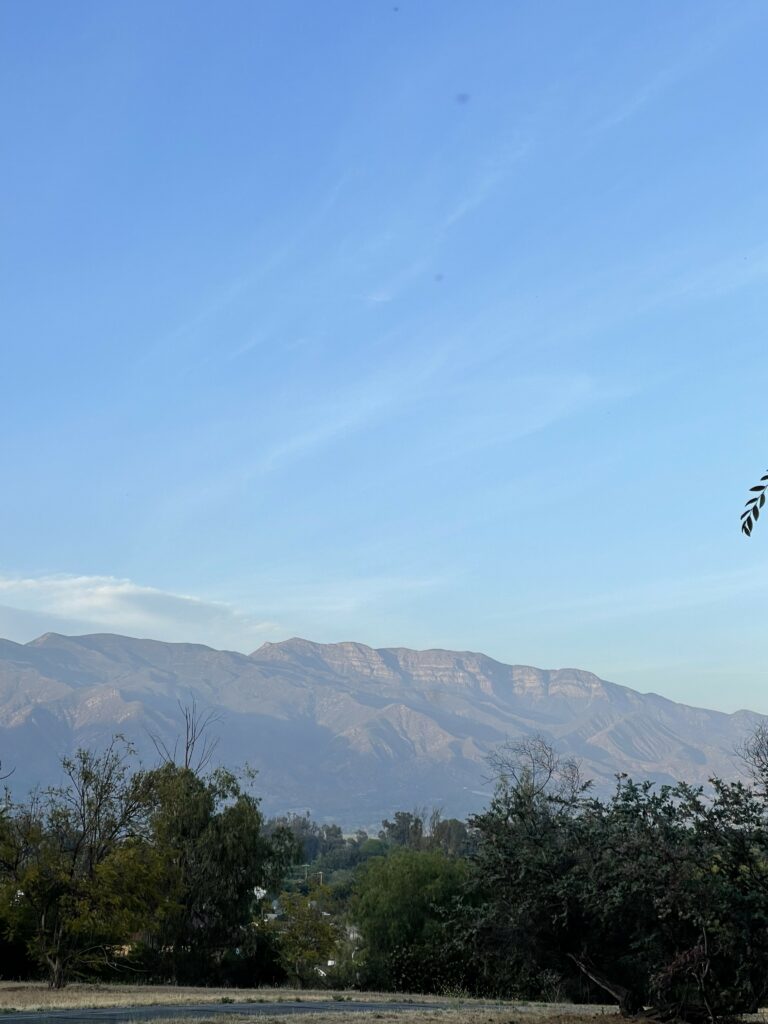
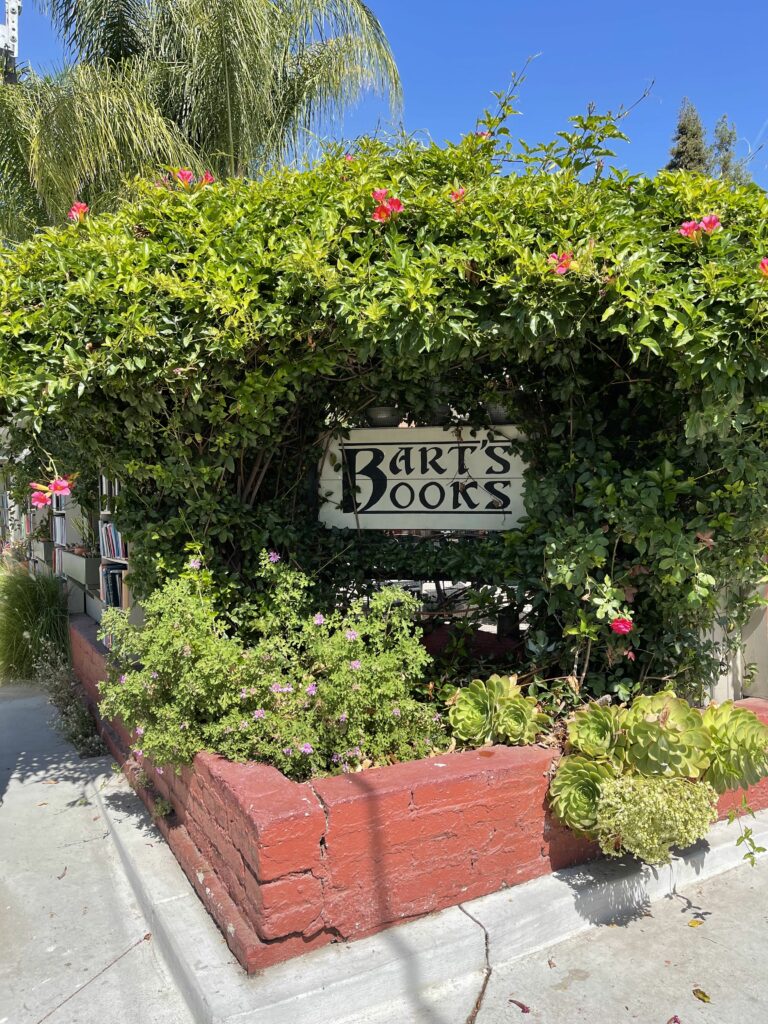
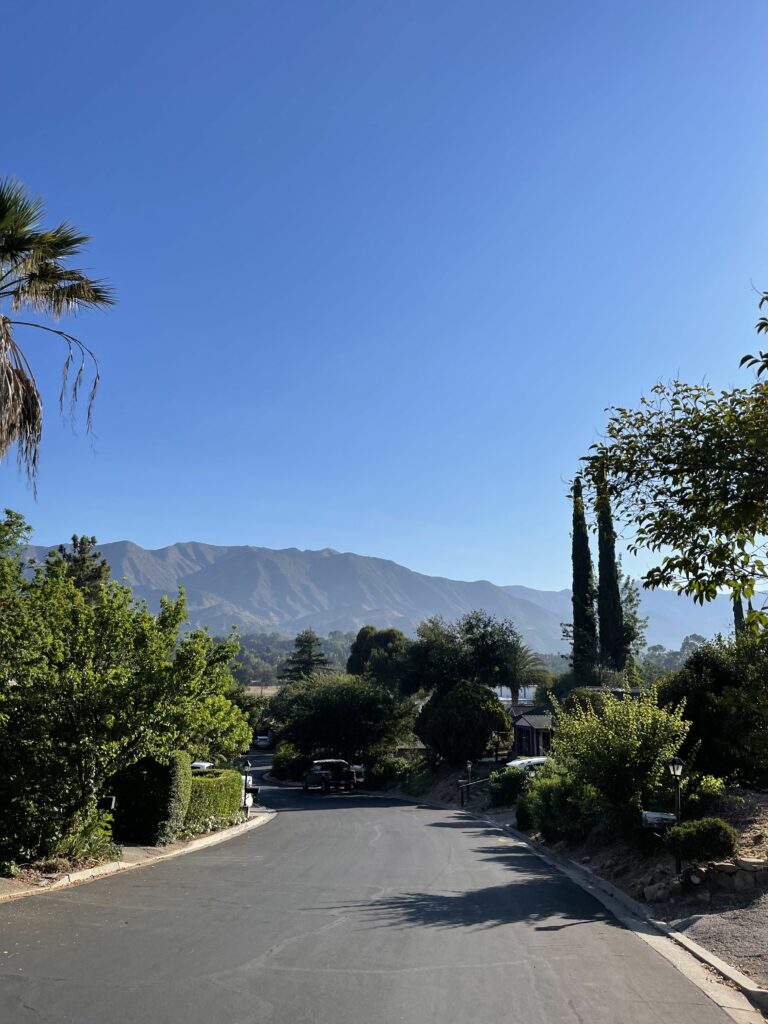
Music Sounds Better in Ojai
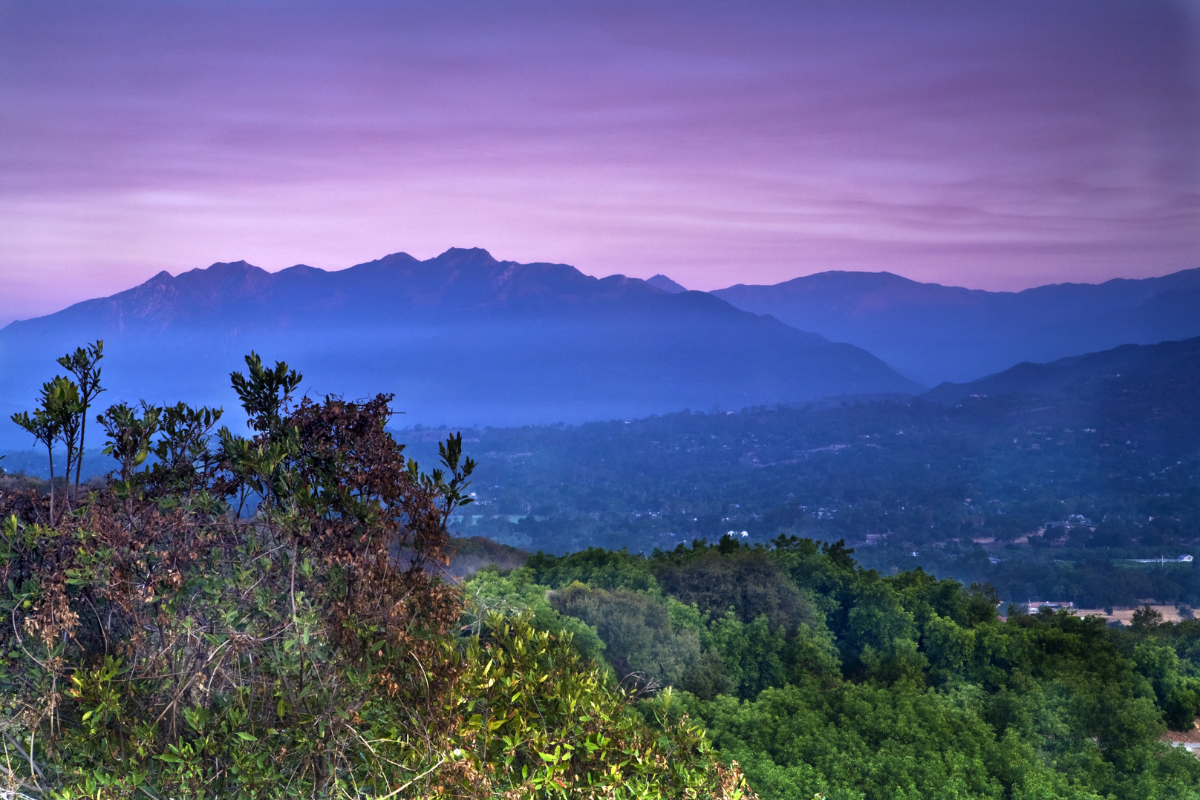
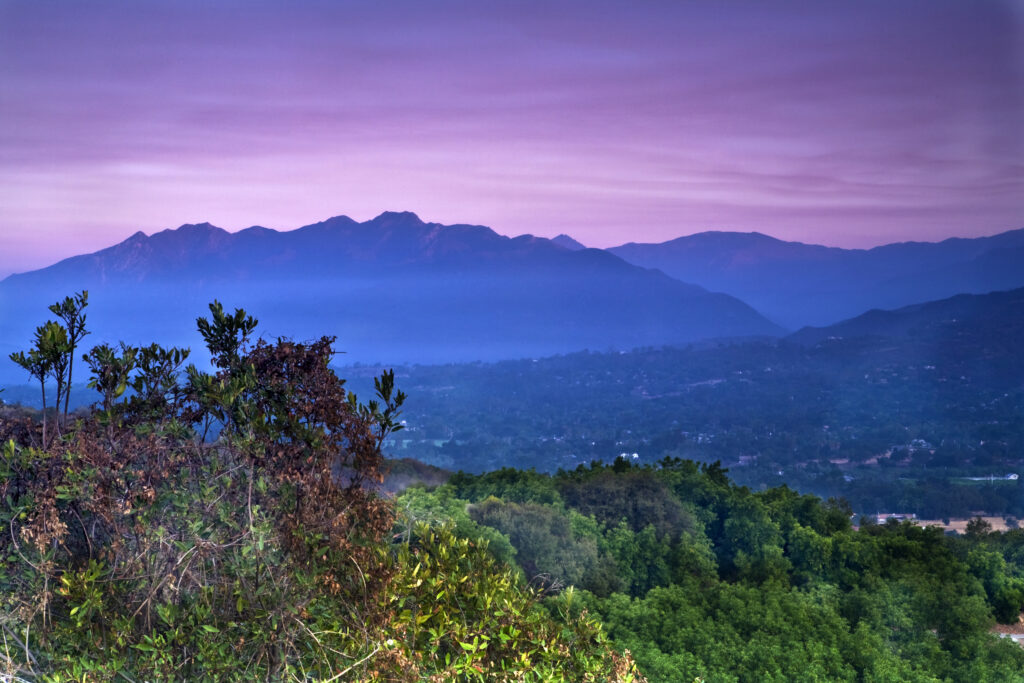
Calling all artists, illustrators and music enthusiasts:
Enter our Design Challenge!
The Ojai Valley is known to be a special place that inspires the arts to flourish like music! The Festival is asking you to show us how music sounds better in Ojai by submitting your original artwork incorporating the words “Music Sounds Better in Ojai” to our 2023 Festival Design Challenge. The winning design will be shared on limited edition merchandise like stickers and t-shirts, plus on our website and social media platforms.
Ignite your imagination!
Your design should reflect creative innovation, the spirit of adventure, and surprise, as these are synonymous with the Ojai Music Festival for the last 77 years!
How it works:
Submission Guidelines and Deadlines
February 17: Call for artists is announced
March 10 PST by midnight: Submissions due
March 17: Winner announced
The final winners from each age category will be announced March 16 and receive two free 4-day series passes to this year’s Festival, plus limited-edition merchandise, and your work featured on our website, Instagram, and newsletter. Our second and third prize winners will receive a pair of lawn tickets and their designs will also be listed on our Instagram and Website.
Guidelines
- All entries must be submitted on or before midnight March 10 PST
- All entries must include the phrase “Music Sounds Better in Ojai”
- There is no fee to submit
- The winning design will receive two series passes to the 2023 Festival, merchandise with design
- There are two categories: middle school to high school and adults 18+ (Entrants under the age of 18 must have a parent or guardian sign the application)
- Submission must be accompanied by the completed form (see link below)
- Incomplete entry forms will be deemed invalid, and artwork will not be judged
- All submitted designs and source images must be the original work of the person submitting the application. Third-party artwork or images, including clipart or copyrighted graphics, may not be used
- By submitting an entry, the person agrees that the Ojai Music Festival will become the rightful owner of the image and may alter and or reproduce the image at its discretion
- All entries will be judged on the artwork’s creative ideas that reflect the uniqueness of the Ojai Music Festival
- Judging decisions are final and may not be appealed
- Entries may be shared by the Ojai Music Festival included but not limited to the Festival’s website, email communications, and its social media platforms
- To participate, please complete form and artwork below:
Francesco Turrisi: What’s On My Playlist
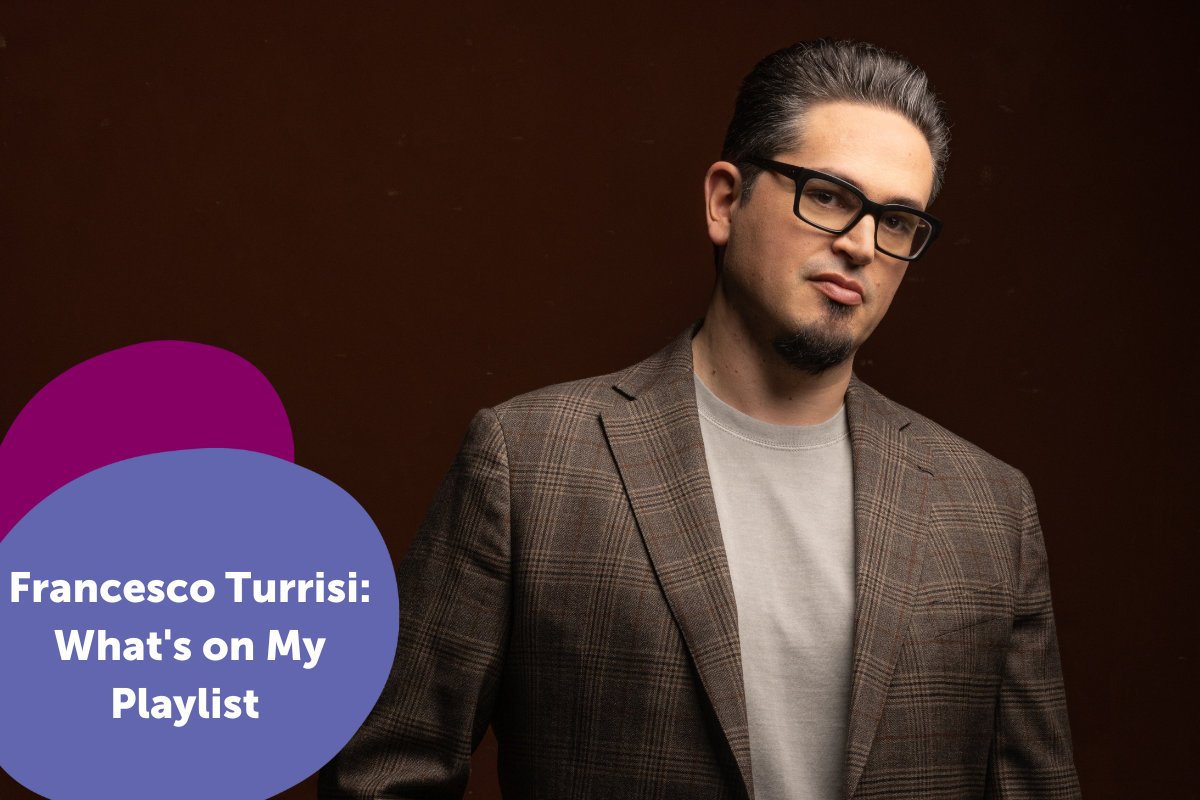
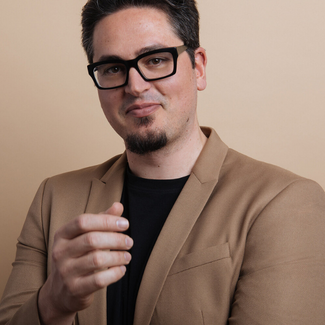
Grammy award winning multi-instrumentalist and 2023 Festival artist Francesco Turrisi has been defined a “musical alchemist” and a “musical polyglot” by the press. Enjoy this wide-ranging music playlist curated by Francesco especially made for the Ojai Music Festival!
PLUS, watch the conversation with Francesco and Festival Artistic Director Ara Guzelimian during our Virtual Ojai Talks in December. Click here >
Preview Francesco Turrisi’s playlist here, and log into Spotify or Apple Music to hear the full songs
SPOTIFY
APPLE MUSIC
Click HERE to listen on Apple Music
1. Slide Dance
by Tamer Pinarbasi, Ismail Lumanovski, Ara Dinkjian
2. Per ogni sorte di strumenti musicale, Op. 22: Passacaglio
composed by Biagio Marini, performed by Jordi Savall and Hespèrion XXI
3. Yo Vivo Enamorado
by Pedrito Martinez
4. Eliasong
by Christian Wallumrød Ensemble
5. Pucciniana
by Guinga
6. Lament for Linus
by Brad Mehldau
7. Sonata Da Chiesa No. 1 in D Major, Op. 5: I. Grave – Adagio – Grave – Allegro – Adagio
composed by Arcangelo Corelli, performed by Accademia Bizantina, Ottavio Dantone, and Stefano Montanari
8. Como al Pie del Suplicio Estuve
by Efrén López
9. La Tarantella dell’Avena
by Zahr
10. Sareri Hovin Mernem
by Lena Chamamyan
BONUS track. Here’s an added piece of music requested by Ojai listeners! Spotify – Passacaglia – song and lyrics by Francesco Turrisi
ENJOY Francesco’s Mom’s delicious “lean” lasagna recipe! Click here >
New Sounds: Ojai On The Air
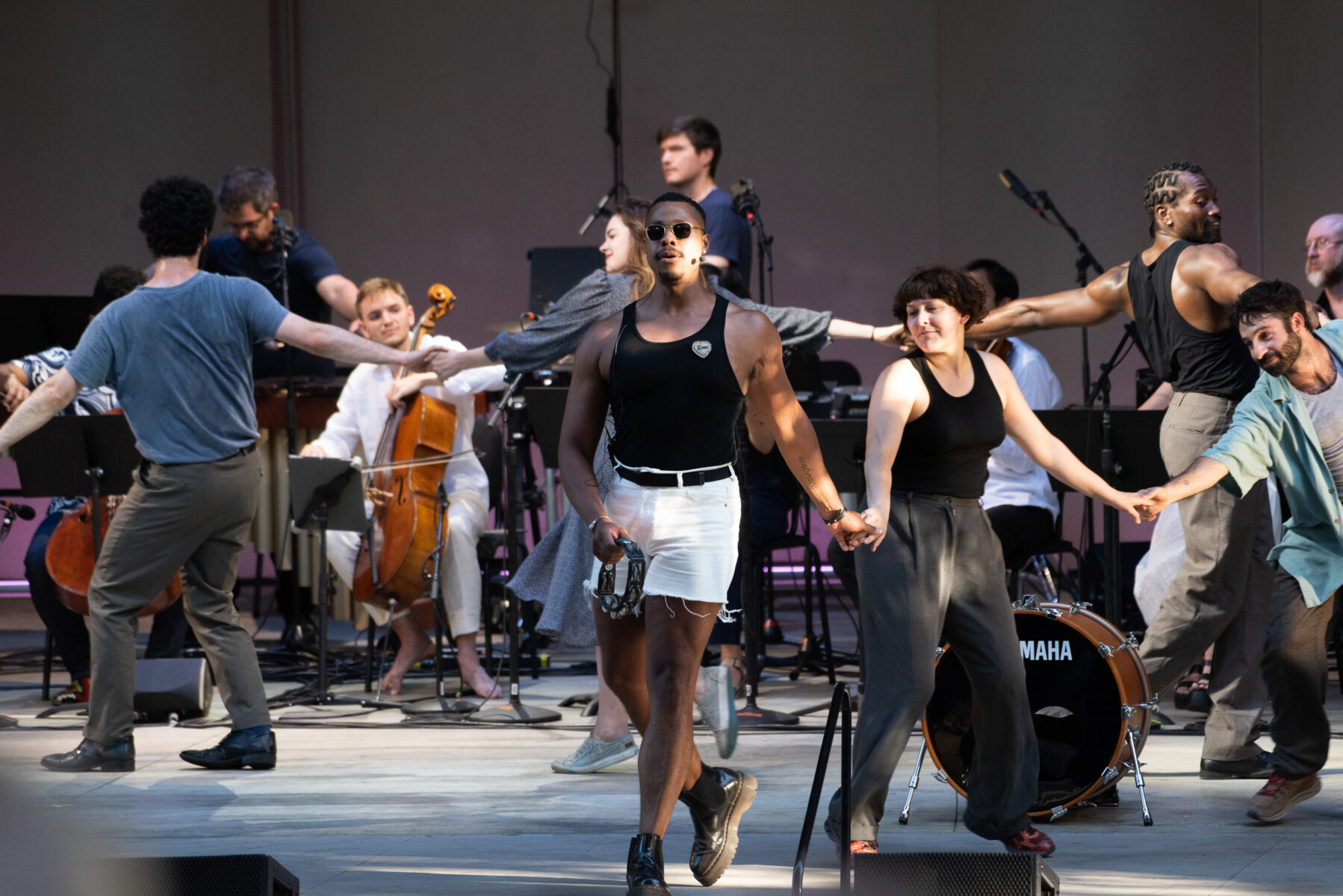

We are delighted to announce a renewed partnership with WQXR Radio and its remarkable New Sounds program, which just celebrated its 40th anniversary with John Schaefer, one of the most adventurous guides to creative and innovative music anywhere.
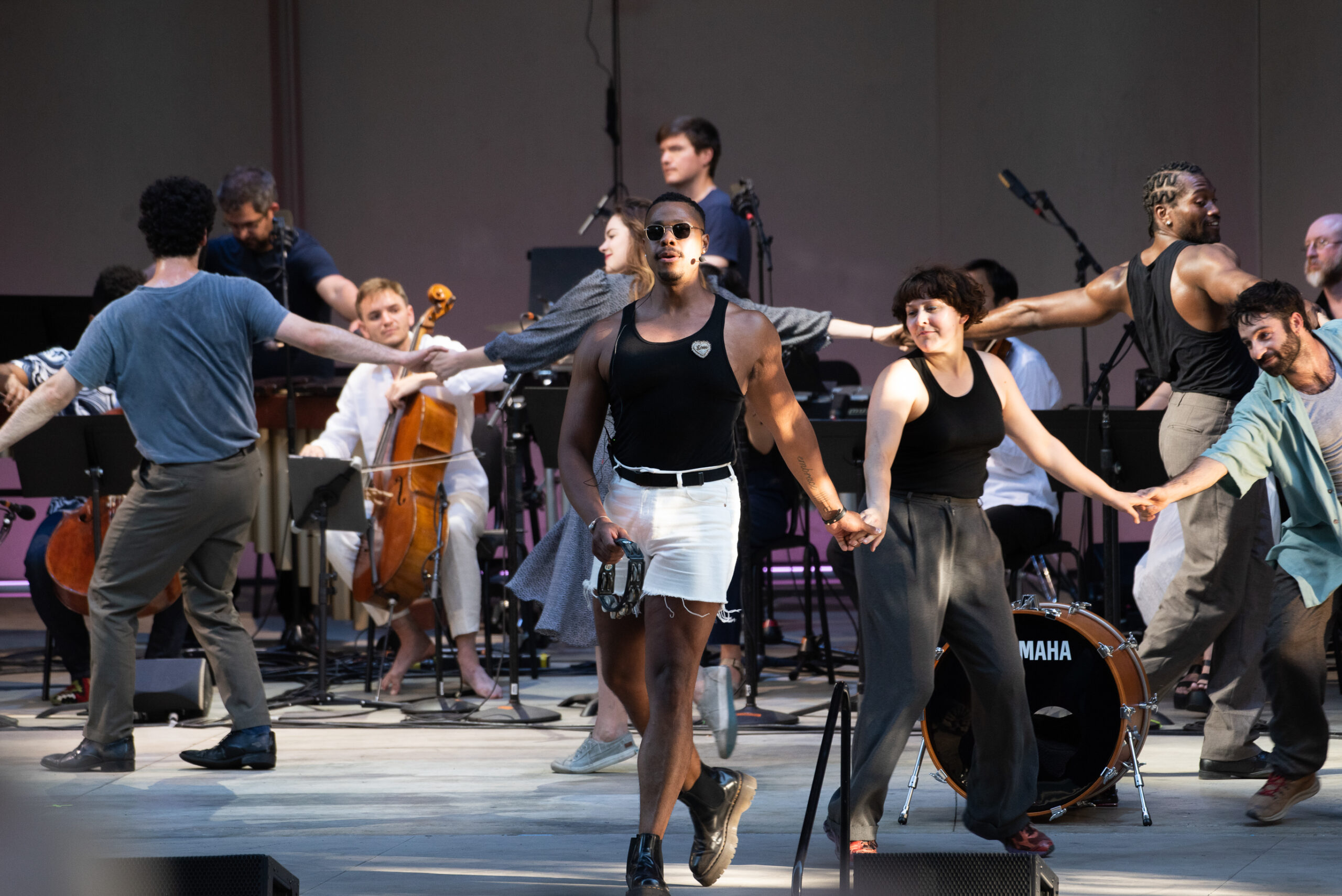
This week-long series of programs will connect audiences with the many facets of the Festival’s 2022 collaboration with the discipline colliding collective AMOC*, Ojai’s 2022 Music Director. Imagined as a vehicle to connect audiences and artists who engage deeply with the world’s most adventurous, new music, WQXR/New Sounds Presents: Ojai On The Air looks toward ongoing programming leading up to and during the 2023 Festival with Music Director Rhiannon Giddens.
CLICK HERE TO LEARN MORE
Check out the episodes below along with featured clips:
EPISODE 1>>
Davóne Tines and New Sounds host John Schaefer discuss Julius Eastman’s work, Tines’ connection to Eastman’s lineage, and how the program Tines and AMOC* prepared honors Eastman as a complete human, exploring the breadth and depth of his life and influence.
EPISODE 2>>
Listen to members of AMOC* performing Little Jimmy by violinist and composer Andrew McIntosh (of new music band Wild Up), and songs of drummer/composer Tyshawn Sorey and American composer Margaret Bonds, performed by bass-baritone Davóne Tines.
EPISODE 3>>
AMOC* member and pianist Conor Hanick plays and discusses The Book of Sounds by the late German pianist, composer, and broadcaster, Hans Otte.
EPISODE 4>>
Listen to a program of J.S. Bach which upends expectations, as arranged by AMOC* member, flutist and composer Emi Ferguson and the period instrument band Ruckus. Plus, from the 2022 Festival Finale, a performance of Julius Eastman’s work of resistance as an act of joy, Stay On It.
Rhiannon Giddens, 2023 Music Director
 The acclaimed musician Rhiannon Giddens uses her art to excavate the past and reveal bold truths about our present. A MacArthur “Genius Grant” recipient, Giddens co-founded the Grammy Award-winning Carolina Chocolate Drops. She most recently won a Grammy Award for Best Folk Album for They’re Calling Me Home, and was also nominated for Best American Roots Song for “Avalon” from They’re Calling Me Home, which she made with multi-instrumentalist Francesco Turrisi. Giddens is now a two-time winner and eight-time Grammy nominee for her work as a soloist and collaborator.
The acclaimed musician Rhiannon Giddens uses her art to excavate the past and reveal bold truths about our present. A MacArthur “Genius Grant” recipient, Giddens co-founded the Grammy Award-winning Carolina Chocolate Drops. She most recently won a Grammy Award for Best Folk Album for They’re Calling Me Home, and was also nominated for Best American Roots Song for “Avalon” from They’re Calling Me Home, which she made with multi-instrumentalist Francesco Turrisi. Giddens is now a two-time winner and eight-time Grammy nominee for her work as a soloist and collaborator.
They’re Calling Me Home was released by Nonesuch last April and has been widely celebrated by the NY Times, NPR Music, NPR, Rolling Stone, People, Associated Press and far beyond, with No Depression deeming it “a near perfect album…her finest work to date.” Recorded over six days in the early phase of the pandemic in a small studio outside of Dublin, Ireland – where both Giddens and Turrisi live – They’re Calling Me Home manages to effortlessly blend the music of their native and adoptive countries: America, Italy, and Ireland. The album speaks of the longing for the comfort of home as well as the metaphorical “call home” of death.
Giddens’s lifelong mission is to lift people whose contributions to American musical history have previously been erased, and to work toward a more accurate understanding of the country’s musical origins. Pitchfork has said of her work, “few artists are so fearless and so ravenous in their exploration,” and Smithsonian Magazine calls her “an electrifying artist who brings alive the memories of forgotten predecessors, white and black.”
Among her many diverse career highlights, Giddens has performed for the Obamas at the White House and received an inaugural Legacy of Americana Award from Nashville’s National Museum of African American History in partnership with the Americana Music Association. Her critical acclaim includes in-depth profiles by CBS Sunday Morning, the New York Times, the New Yorker, and NPR’s Fresh Air, among many others.
Giddens was featured in Ken Burns’s Country Music series, which aired on PBS, where she spoke about the African American origins of country music. She is also a member of the band Our Native Daughters with three other black female banjo players, Leyla McCalla, Allison Russell, and Amythyst Kiah, and co-produced their debut album Songs of Our Native Daughters (2019), which tells stories of historic black womanhood and survival.
Giddens is in the midst of a tremendous 2022. She announced the publication of her first book, Build a House (October 2022), Lucy Negro Redux, the ballet Giddens wrote the music for, had its premiere at the Nashville Ballet (premiered in 2019 and toured in 2022), and the libretto and music for Giddens’ original opera, Omar, in collaboration with Michael Abels, based on the autobiography of the enslaved man Omar Ibn Said, premiered at the Spoleto USA Festival in May. Giddens is also curating a four-concert Perspectives series as part of Carnegie Hall’s 2022–2023 season. Named Artistic Director of Silkroad Ensemble in 2020, Giddens is developing a number of new programs for that ensemble, including one inspired by the history of the American transcontinental railroad and the cultures and music of its builders.
As an actor, Giddens had a featured role on the television series Nashville.
photo by Ebru Yildiz
2022 Festival Photos
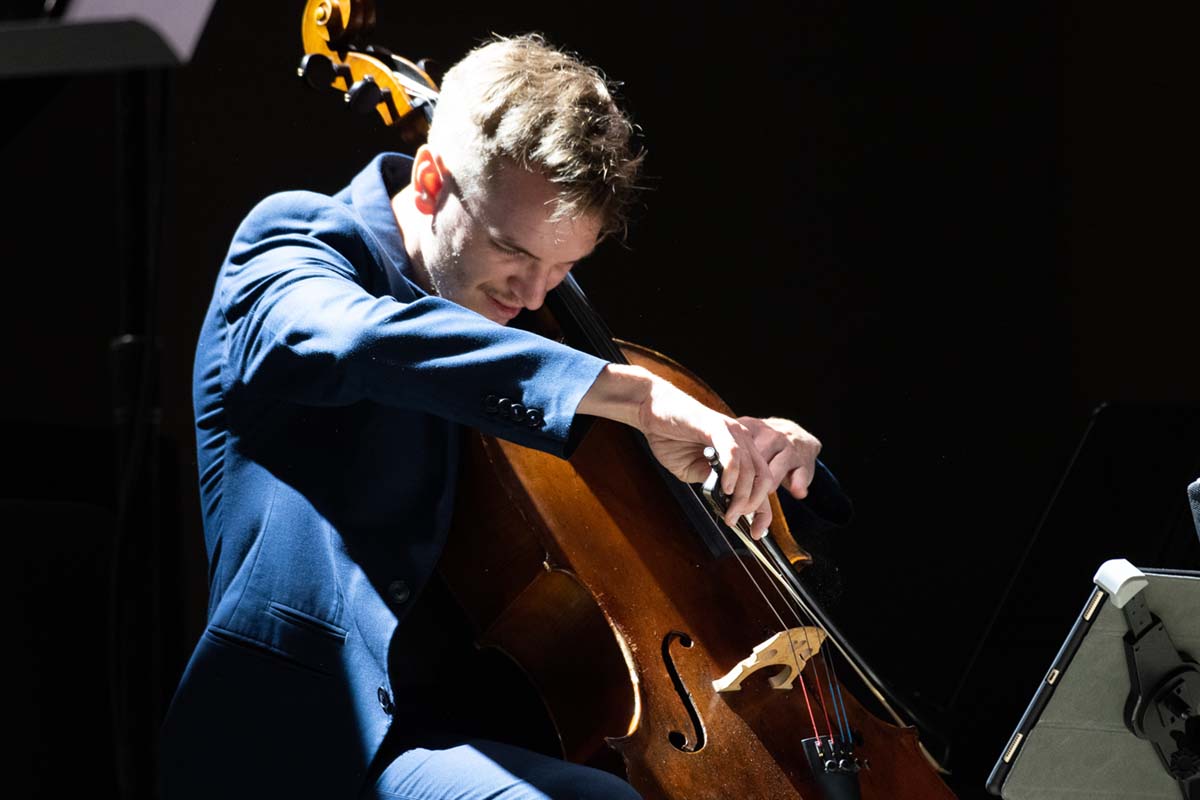
Photos by Timothy Teague
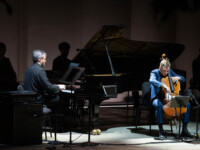
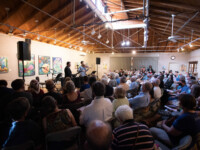
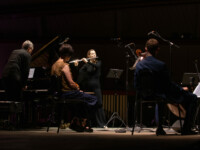
Photos by Joshus S. Rose
Festival Patron Photos by Timothy Teague
2022 Festival Critical Acclaim
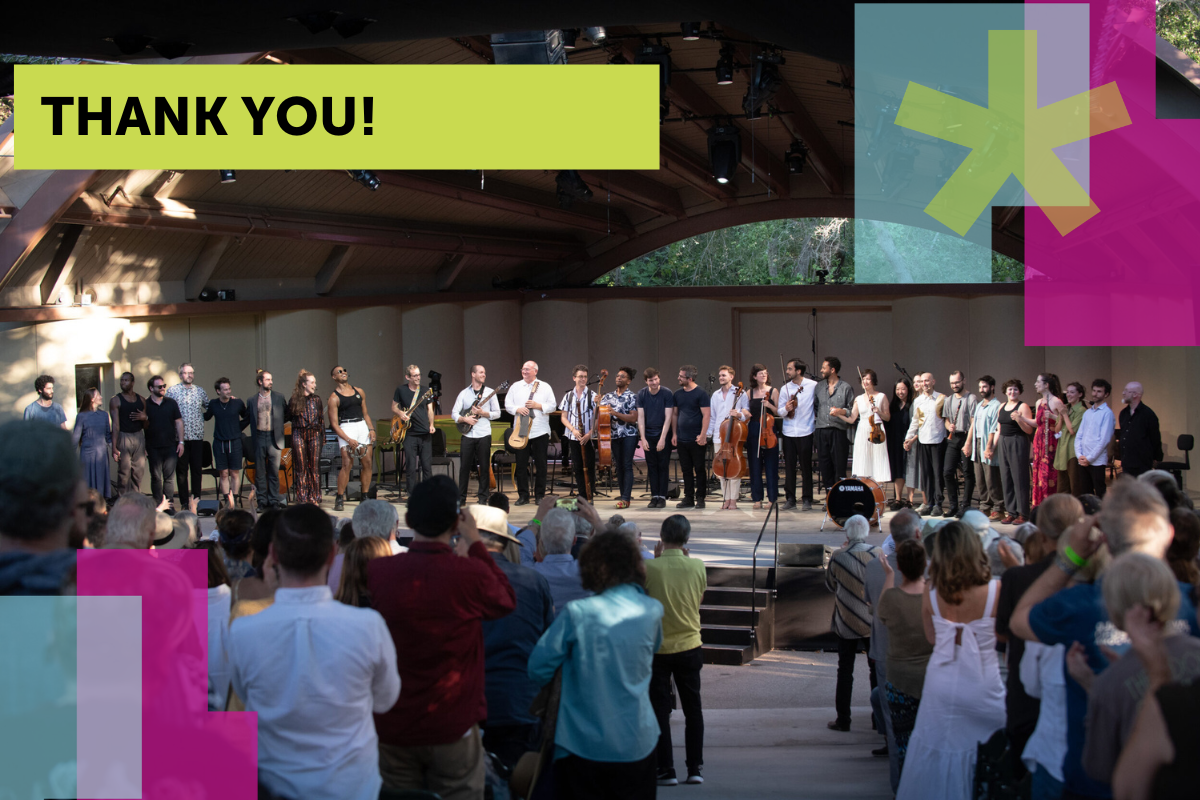

Thank you for joining us at our 76th Festival, June 9-12, 2022. It was an exhilarating time! The energy and boundless creativity of AMOC* was vividly present across the Ojai Valley, giving all of us an extraordinary artistic adventure. Read review excerpts below.
Relive concerts anytime by watching our archived live streaming concerts
View our photo gallery of some of our favorite Festival moments.
“The Ojai Music Festival has always been more than the sum of its considerable parts, thanks to its compact duration (little more than a long weekend), eclectic classical programming, embrace of other disciplines (including theater, dance and spoken word), and sustained ability to attract luminaries to its still delightfully rustic outdoor setting—Igor Stravinsky, Aaron Copland and Pierre Boulez remain the most famous of its annually appointed music directors. Yet this year, something else pervaded, too: a feeling that the center of the classical-music universe, at least from June 9 through 12, was right here.” – Wall Street Journal
“Davóne Tines, in a program note describing amoc’s approach to Eastman’s unswervingly radical music, wrote, “What is possible if all members of a performing ensemble are present for every step of the creation of a performance?” Ojai made the possibilities clear.” – The New Yorker
“There is nothing in music quite like Ojai, now three-quarters of a century old, with that packed morning-to-night-schedule, its variety of spaces and the stalwart curiosity of its audience. Led by Ara Guzelimian with a steady hand, the festival is Southern California relaxed — T-shirts and shorts, maybe a hoodie at night — but the repertory tends rigorous and recondite.” – New York Times
“This Utopian collective of 17 extraordinary artists happily reinventing opera was the communal music director last weekend for the 75th anniversary of this ever-quixotic festival.” – Los Angeles Times
“Eastman’s beloved half-hour Gay Guerilla was a standout moment during the program — and the festival. The dizzily ecstatic work came off as a musical statement at once unruly and internally logical, raucous and yet reflective, as was Eastman’s complex musical wont. Among other distinguishing marks at Ojai 2022, Eastman now joins the ranks of the festival’s ever-expanding songbook of 20th- and 21st-century greats whose music left a mark in this dreamy outpost of a town.” – San Francisco Classical Voice
“Open Rehearsal, directed by the choreographer and dancer Bobbi Jene Smith, felt more nuanced. An outgrowth of Smith’s recent work “Broken Theater,” it is a wry, sometimes uproarious and poignant metatheatrical riff on the process of creation.” – New York Times
“For all its worldly trappings, as an annual gathering point for internationally-respected musicians, composers, conductors, plus visitors and press from near and far, the unique power of the Ojai Music Festival (ojaifestival.org) is partly rooted in its “village” concept. As the cliché goes, it “takes one” to pull all the festival pieces together and it is one, a golden west coast destination spot.” – Santa Barbara Independent
“With AMOC’s boundary-pushing tenure at an end, Ojai has once more proved the most elastic of music festivals. And it seems clear that Mr. Guzelimian intends to continue stretching things.” – Wall Street Journal
“Compositional styles ran a wide gamut at the festival, from the ethereal simplicity of Cassandra Miller’s “About Bach” to the riotous, pop-flavored eclecticism of Doug Balliett’s mini-opera Rome Is Falling.” – The New Yorker
“Everything for AMOC is sacred in that it needs to perform at the highest level, but nothing is so sacred that it can’t be rethought musically, socially, racially, sexually, theatrically, physically.” – Los Angeles Times
“Many in the arts these days talk a big game about interdisciplinary collaboration, but few walk the walk like AMOC” – New York Times
Caffeine Scene
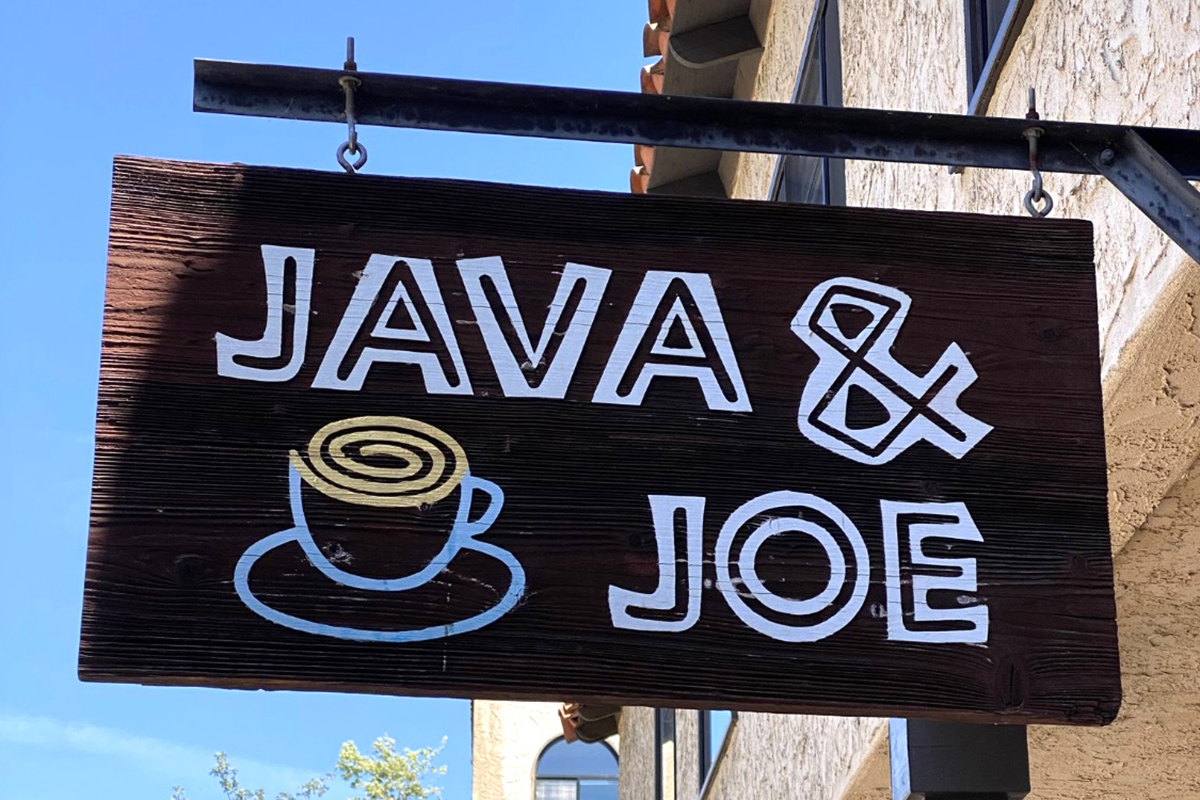
Where to get a cup of coffee (and more) in Ojai
By Lisa McKinnon
First-time visitors to downtown Ojai may be surprised when they go looking for a Starbucks: There isn’t one, thanks to a moratorium on chain businesses with five or more locations. Luckily, Ojai Music Festival audiences in need of a caffeinated pick-me-up between song cycles and dance-theater pieces have plenty of non-corporate options from which to choose.
Beacon Coffee Co., 211 W. Ojai Ave., no phone, beaconcoffee.com. Daily from 7 a.m. to 2 p.m.
Beans sourced from small farms in Kenya, Costa Rica and Guatemala are roasted at the café’s sister location in Ventura, then featured in pour overs, flat whites, cappuccinos and seasonal mochas (the festival coincides with Beacon’s annual switch from Ojai Pixie to lavender, the latter from Frog Creek Farm in the Upper Ojai). Magic Hour teas blended in Ojai are available hot or cold. The café’s kitchen is home to SunOven gluten-free vegan bakery, which produces lavender-lemon doughnuts among other treats. Additional baked goods are from Frontside Cafe in Ventura.

Café Boku, 987 W. Ojai Ave., 805-650-2658, cafeboku.com. Daily from 8 a.m. to 5 p.m.
The menu of organic, plant-based food and drinks infused with ingredients from Ojai-based Boku Superfoods includes coffees and espressos made from locally roasted beans from Bonito Coffee Roaster. Enjoy an invigorating Golden Shroom Latte while juicing up your electric car at the café’s bank of chargers.
Coffee Connection, 311 E. El Roblar Drive, Meiners Oaks, 805-646-7821, coffeeconnectionojai.com. 6 a.m. to 1 p.m. Mondays through Saturdays.
Look for the orange patio umbrellas to locate this off-the-beaten path local favorite specializing in organic, fair-trade coffee, espresso and loose-leaf teas. Drinks are available hot or cold. You’ll also find Mexican hot chocolate and baked goods.
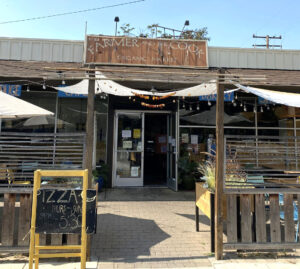
Farmer and the Cook, 339 W. El Roblar Drive, Meiners Oaks, 805-640-9608, farmer-and-the-cook.com. 8 a.m. to 4 p.m. Mondays through Wednesdays, 8 a.m. to 8 p.m. Thursdays through Sundays.
The combination organic bakery, market and Mexican café with vegan, vegetarian and gluten-free options also operates as a community gathering place and espresso bar with drip coffee and specialty drinks. “Beneficial” beverages like the Turmeric Toddy and adaptogenic hot chocolate (made with fungi) are available from 9 a.m. to 2 p.m.

Java & Joe, 323 E. Matilija St., Suite 105, 805-646-3138, javajoeojai.com. Daily from 7 a.m. to 5 p.m.
Nearing its 28th anniversary, the coffeehouse offers an ever-changing lineup of roasts, plus specialty drinks that can be made hot or cold. There’s also a wide selection of whole beans, loose-leaf teas and mugs, carafes and tea pots to take home as gifts.
Love Social Café, 205 N. Signal St., 805-646-1540, lovesocialcafe.com. Daily from 8 a.m. to 2 p.m.
Dune Coffee from Santa Barbara is featured, both freshly brewed and on nitro (cold). The café also serves lattes, cappuccinos and the eye-opening Gibraltar/Cortado – a double espresso topped with an equal amount of micro foam. Fresh-squeezed orange juice and matcha lemonade are also available.
Ojai Coffee Roasting Co., 337 E. Ojai Ave., 805-646-4478, facebook.com/OjaiCoffee. 6 a.m. to 2 p.m. Mondays through Fridays, 6 a.m. to 4 p.m. Saturdays and Sundays.
Owner and roaster Stacey Jones is often behind the counter at the café she opened in 1995 (and which served as a filming location for the 2010 movie “Easy A” starring Emma Stone). Arabica beans are roasted on site in small batches for coffees, espressos, red eyes (espresso plus drip coffee) and more. Check the specials board for lattes ranging from lavender to honey cinnamon.

Pinyon, 423 E. Ojai Ave., no phone, pinyonojai.com. 9 a.m. to 9 p.m. Thursdays through Sundays.
In a nod to the coffee-served-all-day tradition set by the pre-moratorium Jersey Mike’s that previously occupied its address, Pinyon serves French-press hot and cold-brew versions of Los Angeles-based Canyon Coffee from opening till close.

Sage Cafè, 217 E. Matilija St., 805-646-9204, rainbowbridgeojai.com/sage. 8 a.m. to 3 p.m. Wednesdays through Sundays; 5-7:30 p.m. Wednesdays through Saturdays.
Keeping track of your caffeine intake? A “none-to-high” scale for teas is spelled out on glass display case at this counter-service restaurant that also serves drip coffee, collagen lattes and herbal tonics.

The Dutchess, 457 E. Ojai Ave., 805-640-7987, thedutchessojai.com. Daily from 7 a.m. to 9:30 p.m.
Named for a vintage bread oven, the Rustic Canyon Family restaurant operates as a coffeehouse from 7 a.m. to 4 p.m.-ish, when the focus is on order-at-the-counter service of Bonito Coffee drinks and Magic Hour teas (including a heavy-caffeine black variety dubbed Organic Flower Dutchess) to go with grab-and-go sandwiches, cookies, seasonal-ingredient cakes and artisanal breads by pastry chef/partner Kelsey Brito and bread baker/partner Kate Pepper. The Dutchess switches to sit-down dinner mode at 4:30 p.m., when its California-Burmese menu becomes available.
Westridge Midtown Market, 131 W. Ojai Ave., 805-646-4082, westridgemarket.com. Daily from 7 a.m. to 9 p.m.
Fans of Peet’s Coffee will find the brand served at the service deli.
Lisa McKinnon is Ventura-based food writer who drank a LOT of coffee and still managed to fall asleep during a special, four-hour performance at the 2002 Ojai Music Festival — but only because audience members were invited to bring pillows and blankets and told get comfortable on the Ojai Art Center floor for the duration. She’s on Twitter, Instagram, Facebook and TikTok as 805foodie, and blogs at 805foodie.com.


